General Aircraft Company Ltd, Mascot Aerodrome, Sydney 1929-1933
Compiled by Geoff Goodall
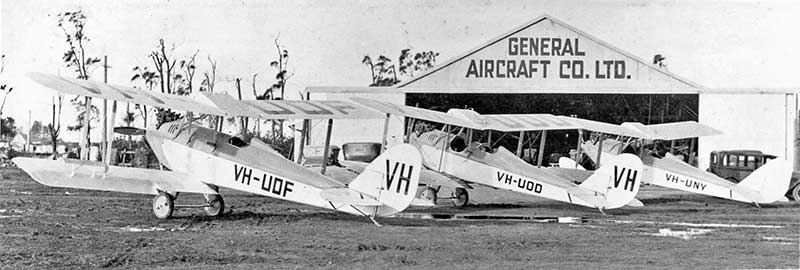
These were Genarco open cockpit models with 105hp Cirrus Hermes engines. Photo: GAC via Frank Walters collection
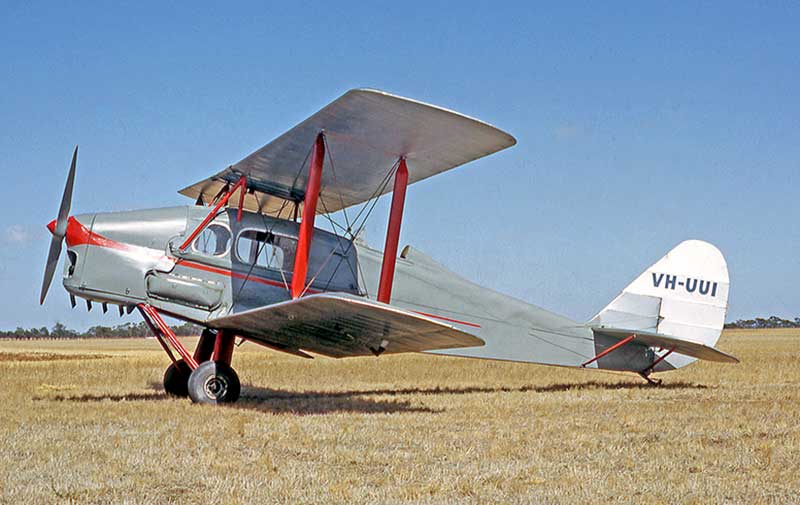
VH-UUI (c/n 17) is seen visiting an airshow at Swan Hill Vic in March 1965. Photo by Neil Follett
The later Genairco development, the Genairco Cabin, has been dismissed as a copy of the DH.83 Fox Moth. However work on the prototype had commenced in Sydney six months before news of the new DH.83 had reached Australia in those days before air mail.
Royal was General Manager. He owned a block of land just outside the boundary of Mascot Aerodrome, on which they had a hangar built and the boundary fence opened up to allow direct access to the airfield. The new company got off to a promising start, gaining much local aircraft overhaul and maintenance work and investing in the latest plant and equipment. GAC gained a reputation for finishing jobs on time and under George Beohm as Works Manager, the quality of their workmanship impressed the Civil Aviation Branch.
A contract was gained with RAAF to overhaul and repair six RAAF DH.60 Moths and 24 spare wings. Three DH.60Xs were also constructed for the civil market, without any licence or approval by De Havilland. Nevertheless, the company enjoyed a good relationship with De Havilland Aircraft Pty Ltd, the Australian branch of the parent DH company, which at that time was just an agency for DH aircraft, engines and parts, without the engineering staff or facilities to carry out major repair work,
GAC also took on the repair of larger aircraft, including Kingsford-Smith's Fokker trimotor Southern Cross, Les Holden's DH.61 Giant Moth Canberra and Australian Aircraft Services' Larkin Lascowl (ANEC III) VH-UGF Love Bird.
GAC's Moth rebuilds and two fully-constructed new DH.60Xs were assigned GAC construction numbers 1 to 9.
| Genarco c/n | Date built | Aircraft |
| 1 | RAAF DH.60 Cirrus Moth rebuild | |
| 2 | RAAF DH.60 Cirrus Moth rebuild | |
| 3 | RAAF DH.60 Cirrus Moth rebuild | |
| 4 | RAAF DH.60 Cirrus Moth rebuild | |
| 5 | RAAF DH.60 Cirrus Moth rebuild | |
| 6 | RAAF DH.60 Cirrus Moth rebuild | |
| 7 | 7.29 | DH.60X Moth VH-ULH rebuild of crashed G-AUHA |
| 8 | 11.29 | DH.60X Moth VH-UMS floatplane constructed |
| 9 | 12.29 | DH.60X Moth VH-UMT constructed. |
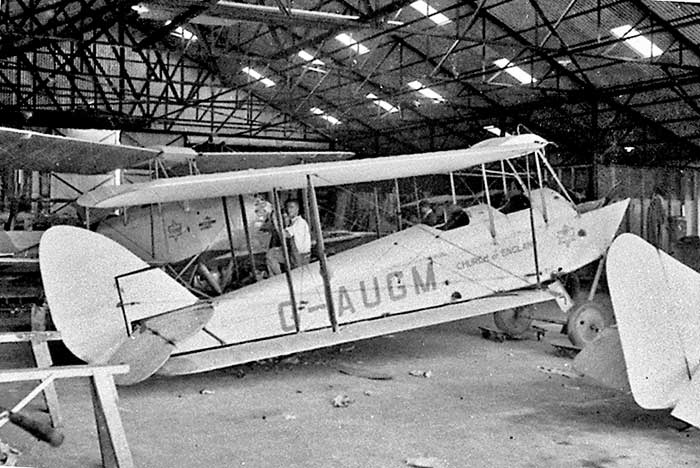
From January 1929 Australian civil aircraft registrations changed from G-AU to the VH-U series.
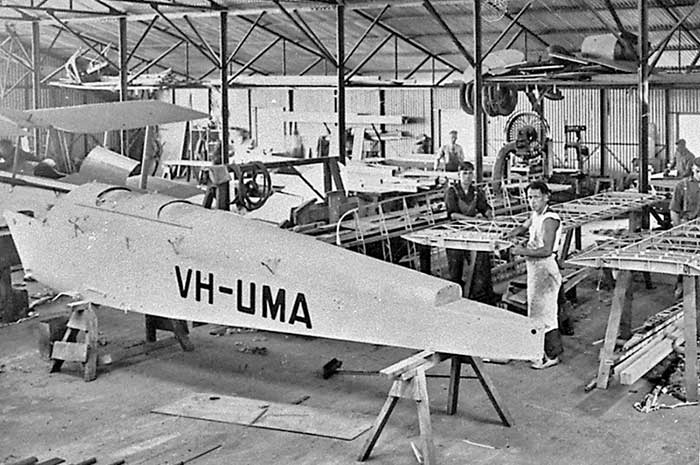
The first official mention came on 15 October 1929 when Albert Royal wrote a letter under the GAC letterhead to the Controller of Civil Aviation advising that "General Aircraft Co has under construction an aeroplane of its own design". Sqn Ldr L.J. Wackett wrote on 5 December that he had been engaged to verify the airworthiness of the new aircraft, which he described as an enlarged version of the DH.60 fitted as a 3 seater. Dual controls would be standard but easily removed from the front cockpit when carrying passengers. Wackett's involvement ensured prompt CAB issue of a provisional Type Certificate.
The prototype VH-UNC made its first flight on 19 December 1929, flown by Jerry Pentland. For publicity, GAC arranged to have it flown by the aviation luminaries of the time including Smithy Charles Kingsford-Smith, Shorty Shortridge and Wackett himself. The second aircraft VH-UNT was purchased by airline pioneer Keith Virtue for joy-riding and is reported to have earned £250 in its first weekend's work. Further promotion came when the fifth Genairco VH-UOF departed Sydney in July 1930 on an attempt to break the Australia-England record, then held by Kingsford-Smith. After a series of forced landings, the flight was abandoned in Burma, but its received a lot of press coverage highlighting the fact that it was an Australian designed and built aeroplane.
The granting of a full Type Certificate by Civil Aviation Branch was a long and at times acrimonious process. GAC complained that it had lost prospective sales in Australia and New Zealand because only a Provisional Type Certificate had been issued. Looking back, it can be seen that the CAB simply did not have the specialist staff needed. Processes for certification of new designs were in their infancy. In an attempt to respond to GAC's criticism, CAB instructed one of its Aircraft Inspectors to carry out a flight test in an aircraft to be provided by the company, provided that Genairco accept all costs. This took place at Mascot on 16 December 1930 in VH-UOD. As well as performance figures, his report made these general comments:
- pilot's view was good, although decreased slightly by the fuselage width
- it was well suited to Australian conditions for instructional and passenger use
- the dual controls and room for two passengers, give it a distinct advantage over other light aircraft in Australia
The Type Certificate was finally issued on 30 June 1932.
- main fuselage structure retained, less the top fairing
- roof portion of the cabin was new, built higher than the original fuselage structure, with laminated hoop-type formers
- cabin door fitted on starboard side, windows on both sides
- seating for 3 passengers inside the cabin
- pilot's seat was moved backwards
- wings were swept back 5 inches at the tips, requiring structural changes at root fittings and centre-section spar
- a new centre-section fuel tank fitted
| Genairco c/n | First flight | |
| 10 | 12.29 | VH-UNC prototype |
| 11 | 4.30 | VH-UNT, VH-UZR |
| 12 | 5.30 | VH-UNY later floats |
| 13 | not used | |
| 14 | 7.30 | VH-UOD |
| 15 | 7.30 | VH-UOF |
| 16 | 10.30 | VH-UOG |
| 17 | 32 | VH-UOH floats, VQ-FAC, to Cabin VH-UUI |
| 18 | 6.32 | VH-UOJ to Cabin prototype, VQ-FAD, VH-UUK |
| 19 | 8.30 | VH-UOS |
| TA-1 | 4.34 | VH-URH floats and canopy over both cockpits, built by Tugan Aircraft using parts from crashed VH-UNY |
Fiji Airways Ltd was founded by George Jeffries, who obtained approval from the Fijian Government in November 1932 for a proposed inter-island air service. The company Fiji Airways Ltd was registered on 1st February 1933 in Adelaide, South Australia, where it had financial backing from Guinea Airways Ltd, home-based in Adelaide. Guinea Airways had built up world-leading New Guinea operations and was keen to start a subsidised air service in Fiji, while preparing to later commence an Adelaide-Darwin trunk route.
Two Genairco floatplanes VH-UOH (open cockpits) and VH-UOJ (Genairco Cabin) were ordered and both shipped from Sydney in February 1933, to become VQ-FAC and VQ-FAD repectively.
The Guinea Airways Board appointed their former Chief Pilot and General Manager Alan S. Cross to be Fiji Airways Ltd's first Managing Director. Behind the scenes the Board had lost confidence in Cross, who had become argumentative and fractuous from the stress of years of managing the expansion in New Guinea, being sent to Germany to negotiate the Junkers trimotors purchase, handling the many disputes with pilots and freight customers, all the time flying the larger aircraft himself. Sending him to Fiji was a preliminary to his dismissal. On his arrival in Fiji, Cross was described in the local press as "a remarkable individual", weighing 120 Kg, his skin covered in tattoos. He was said to be highly impatient with a sharp temper. After his first eventful attempts to fly the Genairco floatplanes, he engaged experienced local aviator Gordon Fenton to fly all Fiji Airways services.
Fiji Airways' company engineer was J. George Beohm previously with General Aircraft Co which was being closed down. His intimate knowledge of the Genairco and their engines proved invaluable.
Passenger services between Fijian islands commenced on 18 March 1933 with the inaugural Suva-Ellington-Lautoka weekly service.
Three days later the inaugural Suva-Levuka-Lambasa weekly service was flown. Disaster struck two months later when VQ-FAC sank in Suva harbour while conducting a test flight for the Administration. It was badly damaged during salvage. After that the Genairco Cabin VQ-FAD maintained all services on a revised round service Suva-Ellington-Lautoka-Makogi-Nabouwalu-Suva, flown by George Fenton. The wooden floats were found to be inadequate, so after the standby aircraft Simmons Spartan VQ-FAA had an accident, its Fairchild metal floats were installed in VQ-FAD.
It has been reported that the original plan was for George Beohm to modify the open-cockpit VQ-FAC to Genairco Cabin standard in Fiji. However it sank in Suva harbour only 3 months after arrival and was badly damaged during salvage. It seems doubtful that Fiji Airways had the funds to divert to the modification to a Cabin model, or even rebuild it at all. Even a skilled engineer like Beohm would have found the task daunting without the support of an equipped aviation workshop. In the event it appears that VQ-FAC did not fly again in Fiji.
Blaming lack of local Government interest and poor patronage, the company only lasted a year, ceasing services in February 1934 and officially closing on 3 March 1934. The two Genaircos were immediately shipped back to Sydney where they were rebuilt and went on to new careers in Australia.
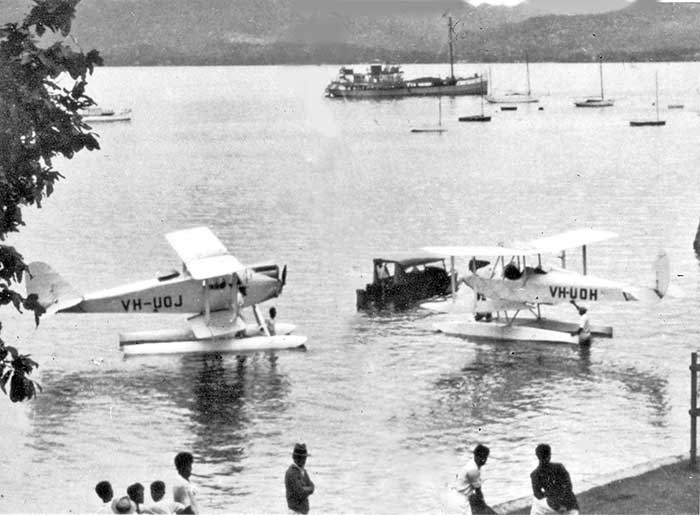
The Genairco Cabin model is on the left. Photo: George Beohm via Frank Walters collection
By 1933 GAC Managing Director Albert Royal was forced to close the business. He arranged to lease the GAC hangar to Leo Turl, an aero engineer then working for Kingsford-Smith and Ulm. In partnership with Frank Gannon, who was working at the Cockatoo Dockyard Aviation Division, a new aircraft maintenance business was formed named Turl and Gannon, soon being re-financed as Tugan Aircraft Company Ltd. Royal sold them GAC plant and parts, including Genairco drawings and the rights to any future Genairco production.
In November 1933 Turl and Gannon began their first job, an order for a replacement Genairco floatplane for Rabaul Airways, which was completed in March 1934 as VH-URH, given a Tugan Aircraft Ltd construction number TA-1. Tugan grew into a busy operation and in association with Lawrence Wackett, produced the Codock and Gannet series of twin-engined airliners. (see Tugan Gannet on this site)
General Aircraft Co Ltd was wound up in April 1933.
An auction sale at the hangar in April 1933 liquidated the company's remaining assets. Left-over Genairco components were acquired by a former GAC fitter Wally H. Kuhl. They were put to good use when Kuhl rebuilt the two Fiji Airways Genaircos when they were shipped back to Sydney. Kuhl had opened his own business at Mascot as WHK Engineering and was a partner in the successful prewar Airflite Pty Ltd at Mascot, which offered maintenance, sales, imports of American light aircraft and a flying school.
| 29 | Built by General Aircraft Co Ltd in their hangar at Mascot Aerodrome, Sydney NSW Completed with two open cockpits, fitted with a 115hp ADC Cirrus Hermes |
| 12.11.29 | Letter
to Civil Aviation Branch from Albert A. Royal of General Aircraft Co:
request civil reguistration be allocated to a "Moth type aeroplane"
which we have just built, with the permission of De Havilland Aircraft
Pty Ltd. |
| 13.12.29 | Registration application: General Aircraft Co Ltd, Cook Street, Mascot Aerodrome, Sydney Signed by J. G. Boehm. C/n 10, fitted with Cirrus Hermes engine |
| 19.12.29 | First flight Macot, pilot Jerry Pentland |
| 20.12.29 | Added to Civil Register: General Aircraft Co Ltd, Mascot Aerodrome, Sydney |
| 25.1.30 | Conducting a series of test flights at Mascot |
| 24.2.30 | Pilot A. N. Pentland certifies to CAB that he has personally flown VH-UNC for 6 hours 30 mins test flying |
| 14.3.30 | General Aircraft Co Ltd certify to CAB that VH-UNC has been flown for 12 hours by pilots A. N. Pentland, Sqn Ldr Lawrence Wackett, Sqn Ldr Charles Kingsford-Smith and T. Shortbridge |
| 19.3.30 | CofA issued |
| 14.4.30 | Change of ownership: Rockhampton Aerial Services Ltd, Rockhampton Qld This company also had a DH.50 VH-UFW and from 1932 commenced scheduled airline services from Rockhampton until taken over by Airlines of Australia in 1936 |
| 23.7.30 | Captain
H. L. Fraser of Rockhampton Aerial Services arrived at Cairns Qld in
his newly-built Genairco and conducted joyflights from Hambledon Sugar
Mill because there was no airfield at Cairns. Fraser was a RAF pilot in
Palestine during WWI. |
| 12.8.32 | Badly
damaged in forced landing near Rockhampton due engine failure. The
company's Chief Pilot H. L. Fraser and passengers were injured |
| Stored damaged | |
| 17.2.36 | Change of ownership: Francis C. Higgins and Mrs. Ethel B. Jones, trading as F. C. Higginson & Co, Archerfield Aerodrome, Brisbane Qld. |
| Rebuilt at Archerfield by ground engineer Joe Vine | |
| 13.8.36 | Test flown Archerfield after repair, pilot F.C.Higginson |
| 11.36 | Higginson installed a DH Gipsy III engine |
| 19.12.36 | Change of ownership: William Crouch, "Killowan" Station via Cunamulla Qld |
| 18.11.39 | Badly damaged in crashed on takeoff at Cunamulla, struck a tree. |
| 25.11.39 | Wreck sold to E. D. Hill, "Rosevale" Station, Wyandra Qld |
| 25.11.39 | Wreck moved from Crouch's hangar Cunamulla to Rosevale Station |
| 40 | VH-UNC rebuilt at Hill's property by a ground engineer engaged to recondition Hill's Avro Avian VH-UFY |
| .40 | VH-UNC ferried Rosevale to Archerfield to have CofA renewed |
| 26.6.40 | VH-UNC testflown Archerfield |
| 27.1.40 | Register change of ownership: E. D. Hill, "Rosevale" Station, Wyandra Qld |
| 24.6.41 | Last log book flight entry |
| 27.6.41 | CofA expired, not renewed |
| 7.41 | VH-UNC is being worked on at Archerfield by volunteer RAAF fitters. E. D. Hill is now a Sergeant in RAAF |
| 5.9.41 | Hill
requests DCA approval for him to ferry VH-UNC from Archerfield to
Cunamulla where he will store it for the duration of the war. No
Departmental written response in DCA file |
| 8.45 | Hill advises DCA that the Genairco is dismantled and stored at Dalby Qld. He plans to have it made airworthy soon |
| 1.46 | Hill advises DCA that he
intends to have the CofA renewal overhaul done by Air Repair Company at
Archerfield under Mr. K. J. Murphy. Hill requests approval to replace the Gipsy III with a DH Gipsy Major. Approved. |
| 9.47 | DCA memo: VH-UNC is at Archerfield undergoing CofA renewal |
| 6.10.47 | Annual CofA expired |
| 12.47 | Hill writes to DCA advising that he now has purchased DH.84 Dragon VH-AYZ and no longer wishes to register VH-UNC |
| 19.12.47 | Struck-off Register |
| Reportedly burnt at West Wyalong NSW in February 1961 |
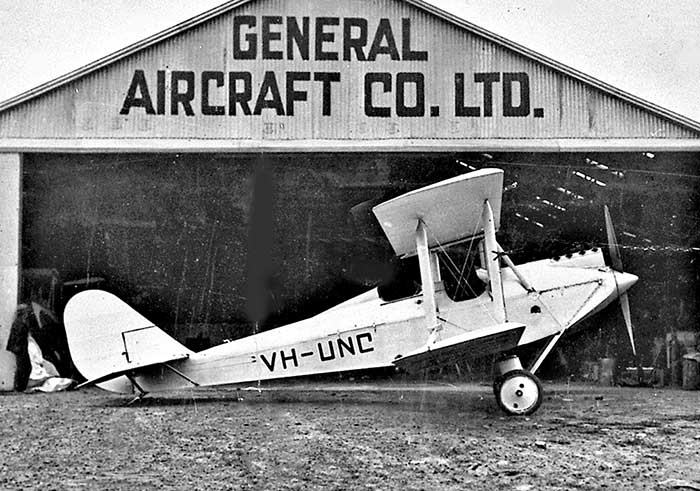
Photo: GAC via John Hopton Collection
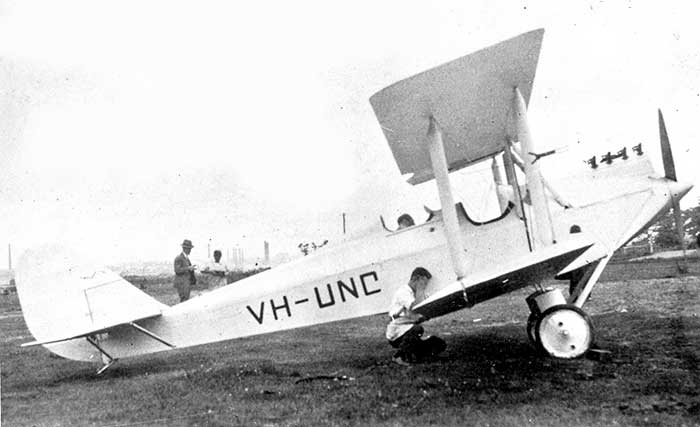
Photo: Frank Walters collection
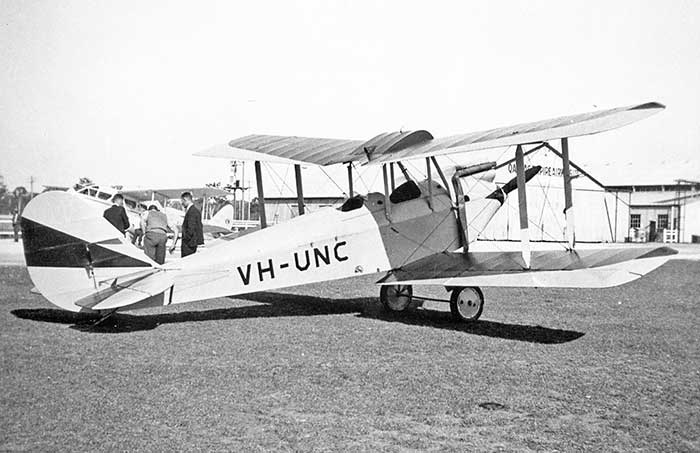
Photo: Reddall Collection via Aviation Historical Society of Australia NSW Branch
| 8.4.30 | Construction completed by General Aircraft Co Ltd in their hangar at Mascot Aerodrome, Sydney NSW Completed with two open cockpits, fitted with a 115hp ADC Cirrus Hermes |
| 9.4.30 | Registration application: General Aircraft Co Ltd, Cook Street, Mascot Aerodrome, Sydney Application signed by Albert A. Royal on behalf of the General Aircraft Co Ltd. |
| 15.4.30 | Added to Register VH-UNT: General Aircraft Co Ltd, Mascot Aerodrome, Sydney |
| 19.4.30 | First flight Mascot, pilot Jerry Pentland |
| 23.4.30 | New Registration application submitted: Ralph & Keith Virtue, Lismore NSW Keith A. Virtue of Lismore shad been making a living giving joyrides to build up finances to start his own airline. In partnership with his brother Ralph, operated charter and flying school as Virtue's Air Travel, Lismore with DH.60G Gipsy Moth VH-UIA. |
| 28.4.30 | Change of ownership: Keith A. Virtue, Lismore NSW |
| The book Virtue in Flying by
Joan Priest is a biography of Keith Virtue. It describes his
barnstorming tours between NSW towns, giving over 20 flights a day from
farmer's paddocks. "So he was able to get ahead of his fuel bill and finally order another aircraft, from the General Aircraft Company at Mascot. He took delivery of the Genairco biplane, which cost him £926 and which was promptly dubbed The Pregnant Moth". With the Genairco and his first pupil Sonny Armstrong of Lismore now having his licence to fly with them, Virtue's Air Travel decided to go west and headed over the Queensland border to joyride at the 1930 Goondiwindi Picnic Races." | |
| 8.8.30 | CAB Inspection Report: good condition |
| 3.11.30 | CAB Inspection Report: some deterioration recorded |
| Keith
Virtue was financed by G.A.Robinson of the New England Motor Company at
Lismore to start an airline service. In the name of the motor
company,Ryan B.1 VH-UIZ was purchased and began passenger services between Lismore, Sydney and Brisbane. A new company was formed by G. A. Robinson effective 1st January 1931 incorporating Virtue's Air Travel, named New England Airways Ltd with chief pilot Keith Virtue. New England Airways expanded and was restructed in October 1935 as Airlines of Australia, flying from Melbourne to Cairns with Stinson A trimotors and DC-3s. Airlines of Australia merged into ANA in 1942. | |
| 1.1.31 | Change of ownership: New England Airways Ltd, Lismore NSW |
| 27.2.31 |
3 month Lease to Captain T. R. "Tommy" Young, Brisbane who had flown for Sky Travel Pty Ltd, Brisbane which had shut down late the prevous year due to the Depression. He took the Genairco on a barn-storming tour to earn income from joyriding. He later said "The three seater Genairco was a very good little aeroplane" |
| 1.3.31 | VH-UNT struck a fence on takeoff at Allora Qld while joyriding. Badly damaged. Pilot Tom R. Young and passengers unhurt. Quickly repaired and returned to joyriding. |
| 3.5.31 |
Tommy Young returned VH-UNT to Keith Virtue at New England Airways. In November that year Young was to join New England Airways |
| 1.4.34 | Crashed into a sand dune, wrecked, when stalled on landing approach at Evans Head NSW. NEAW pilot Jason Hassard was badly hurt and his two passengers died from their injuries. |
| 5.34 | Wreck purchased by Thomas J, Appleby, Brisbane Qld Appleby was a serving policeman and pilot who planned to rebuild the aircraft in an attempt to introduce aviation to the Queensland Police Force. He had engaged experienced ground engineer Joseph Vine to carry out the rebuild in Brisbane, replacing the front open cockpit with an enclosed 2 passenger cabin. |
| 21.5.35 | Test flown Archerfield after rebuilt. No indication of the cabin modification, all pictures show standard two open cockits |
| 2.6.35 | Badly
damaged landing at Rosewood Qld, after the port undercarriage wheel had
been torn off when it struck a tree stump on takeoff on a joyflight.
Pilot was N.Blight, carrying three passengers. Owner was Constable T.
Appleby of Rosewood Police Station. |
| 2.36 | Repairs completed at Rosewood. Ferried from Rosewood to Archerfield Aerodrome, Brisbane for inspection to renew its CofA |
| 18.4.36 | Took part in an air display at Rosewood Qld |
| 27.4.37 | DCA
Archerfield inspector memo: VH-UNT had only flown several times prior
to the June 1935 accident, next flight was the short ferry 40 miles
from Rosewood to Archerfield, then returned to Rosewood to participate
in the air display there April 1936. Since then has not flown because it needs maintenance but engineers Vine, Adair and others at Archerfield will not sign the aircraft out "for various reasons". |
| 23.11.37 | Constable Appleby request ferry permit Rosewoof to Archerfield for overhaul |
| Maintenance carried out by Bill Rankin's Air Service, Archerfield | |
| 2.3.38 | Change of ownership: F. E. Biffin, Casino NSW |
| Airframe rebuilt at Archerfield. Biffin requested DCA issue a new registration because the current marking caused comments | |
| 3.38 | Change of Registration to VH-UZR |
| 25.8.38 | DCA Inspection Report at Archerfield after rebuild. Painted as VH-UZR. 120hp Cirrus Hermes Mk.II engine |
| 12.38 | C.
C. Matheson of Matheson Aviation and Training Co Pty Ltd, Archerfield
wrote to DCA requesting approval to install loud-speakers
to VH-UZR. The owner wishes to use it for aerial advertising over the
Christmas holiday period. DCA approve the design and electrical wiring
modifications |
| Loud-speakers
were installed but trials revealed the broadcast message could not be
heard from the ground. They were then removed. | |
| 4.39 | DCA
Archerfield office memo: VH-UZR has not flown for some time. Matheson
intends to purchase it, but it requires more maintenanceand the owner
wants to replace the Hermes II engine with a DH Gipsy III. |
| 25.9.39 | CofA renewed, retaining the Hermes II engine |
| 16.10.39 | Register belatedly records the Change of Registration to VH-UZR: F. E. Biffin, Casino NSW |
| 5.4.40 | Crashed landing at Archerfield when student R. Howard struck a light pole. It was being operated by Matheson Aviation and Training Co Ltd, Archerfield Matheson was a civil contractor training RAAF cadets prior to the establishment of the RAAF Elementary Flying Traininbg Schools across Australia |
| 7.3.41 | Auction
at Archerfield of the assets of Matheson Aviation and Training Co Ltd,
which placed itself in voluntary liquidation in January 1941. VH-UZR
which had been operated by Matheson until its crash was included in the
auction in damaged condition by owner F. E. Biffin |
| 7.3.41 | Purchased "as is" at the auction for £25 by H. Round, Brisbane Qld |
| 1.5.41 | Mr. H.Round sold the damaged VH-UZR to Stanley Eastwood, Toowoomba Qld. |
| 7.41 | DCA memo: it is now at Toowoomba Qld in dismantled and damaged condition. |
| 18.8.41 | DCA
inspector's inspection report at Stanley Eastwood's house at Toowoomba:
requires major repair work to the airframe and engine. It will need a
complete rebuild. |
| 1.5.41 | Struck-off Register on Change of Ownership (back-dated to sale to Eastwood) |
| Nothing further in the DCA file |
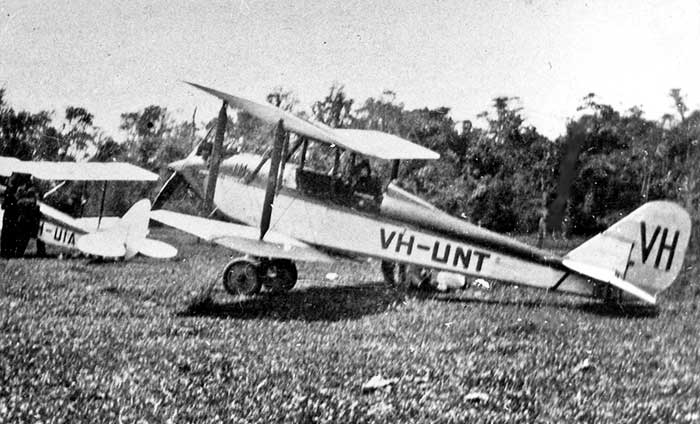
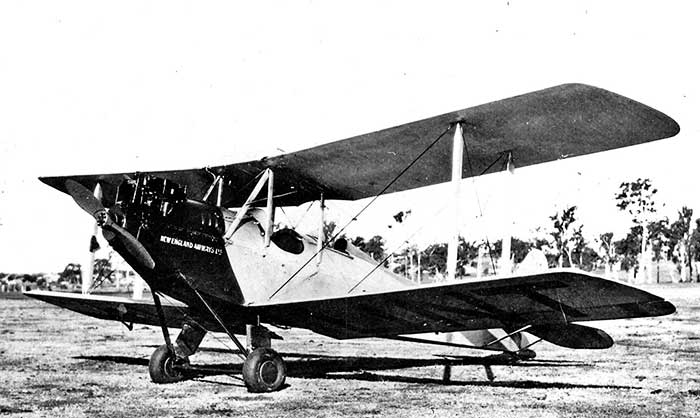
Photo: Frank Walters collection
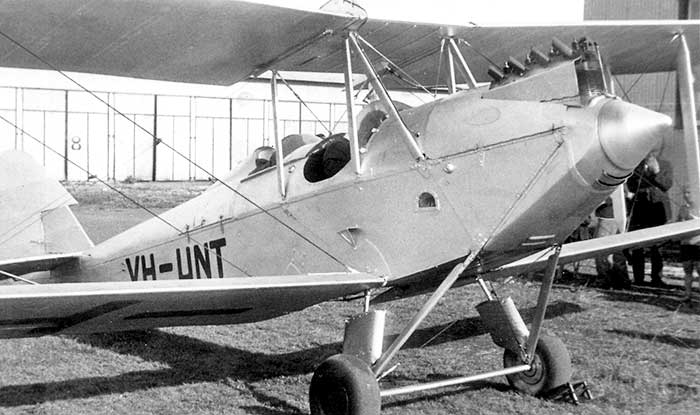
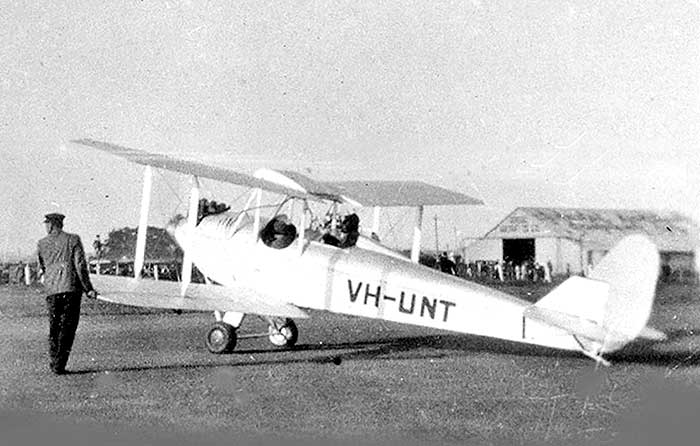
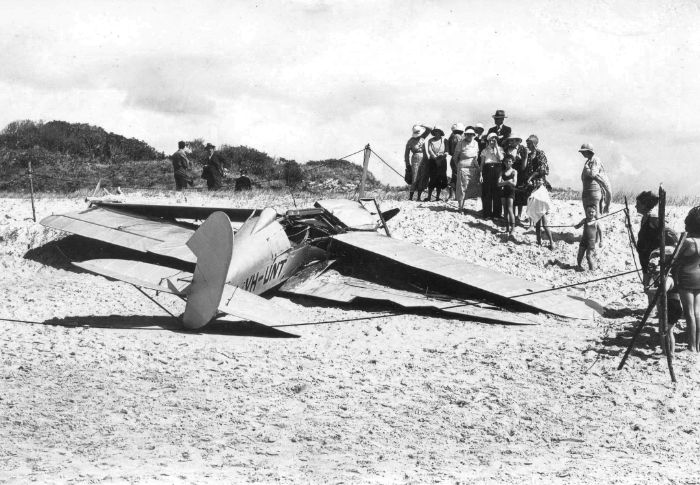
The pilot Jason Hassard was badly hurt, but he went on to log the highest hours of any Australian airline pilot.
Photo courtesy Evans Head Heritage Aviation Museum
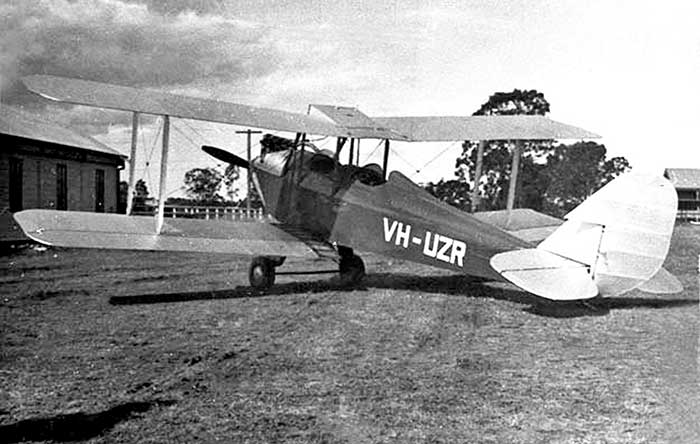
| 30 | Built by General Aircraft Co Ltd in their hangar at Mascot Aerodrome, Sydney NSW Completed with two open cockpits, fitted with a 115hp ADC Cirrus Hermes |
| 6.5.30 | Added to Civil Register VH-UNY: General Aircraft Co Ltd, Cook Street, Mascot Aerodrome |
| 16.5.30 | First flight Mascot |
| 24.1.31 | Change of ownership: Adastra Airways Ltd, Mascot Aerodrome, Sydney NSW |
| 28.4.33 | Crashed at Mascot |
| 7.33 | Sold to Rabaul Airways Syndicate. Fitted with floats Rabaul Airways Syndicate was founded by William J. Duncan, Rapopo Plantation, New Britain who persuaded local businessmen to invest in a floatplane venture. He was previously a Flt. Lt with RAF and was the first Civil Aviation Branch officer stationed in New Guinea region. |
| The wooden floats were designed by L.J.Wackett and built and installed at Cockatoo Dockyard Aircraft Division, Sydney Harbour | |
| 11.8.33 | Test flown Sydney Harbour by William J. Duncan for Rabaul Airways |
| 12.8.33 | Change of ownership: Rabaul Airways Syndicate, Rabaul, New Britain |
| 12.8.33 | Duncan departed in the floatplane VH-UNY on delivery flight to New Britain |
| 21.8.33 | Reached
Port Moresby after a gruelling trip up the Australian coastline.
Aircraft was taken ashore at the Napa Napa slipway for repaiurs to the
floats which had been damaged at Kerema. |
| 8.33 | Forced
landing on the Mambare River on the Samarai-Salamaua leg, due propeller
vibration. Towed 120 miles to Lae by the vessel Wanderer |
| Departed Lae after propeller repairs. now with Charles Gatenby
in the front cockpit. He had resigned his ground mechanic job with
Guinea Airways to join the new Rabaul Airways as their pilot-mechanic. The performced of the floatplane with the extra weight was so poor that Duncan emptied over the side four of his five 4-gallon drums of emergency petrol. | |
| 9.33 | Approaching New Britain
sever tropical weather caused another forced landing on water near
Umbai Island. No damage and the fliers shelted from the storm |
| 26.9.33 | Reached Rabaul on delivery flight |
| 15.10.33 | Crashed when struck a coconut tree Rainau Plantation, Kokopo near Rabaul. That day Duncan flew VH-UNY to Kabakaul, near Rabaul to conduct joyrides to raise funds for the syndicate. With two passengers in the front cockpit he flew over close-by Rainau Plantation where his floats struck a tall coconut tree. The aircradt crashed to the ground, killing one passenger and seriously inuriing the other. Duncan received minor injuries. |
| Parts shipped to Sydney, used in the newly-built Genairco VH-URH constructed by Tugan Aircraft between November 1933-March 1934 | |
| 10.9.34 | Struck-off Register |
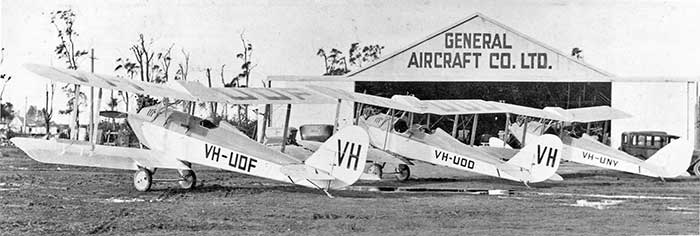
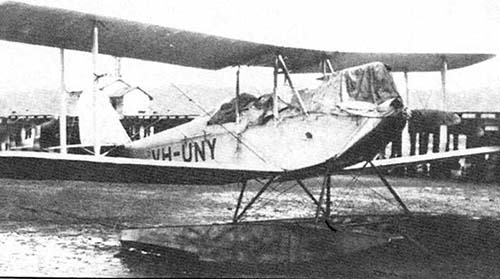
| 16.5.30 | Constructed by General Aircraft Co Ltd in their hangar at Mascot Aerodrome, Sydney NSW Completed with two open cockpits, fitted with a 115hp ADC Cirrus Hermes |
| 2.6. 30 | Added to Civil Register VH-UOD: General Aircraft Co Ltd, Cook Street, Mascot Aerodrome, Sydney |
| 2.7.30 | CAB memo: construction of VH-UOD almost complete |
| 8.7.30 | First flight at Mascot, pilot Leslie Shaw |
| 9.7.30 | CofA issued |
| 2.2.31 | Change of ownership: G. J. Moir, Sydney NSW |
| 2.31 | Albert A. Royal, Manager of General Aircraft Co Ltd wrote to CAB advising that the sale to Moir, who was a dental surgeon, was not concluded. A new sale to the Aero Cub of NSW was being negotiated |
| 5.3.31 | Change of ownership: Aero Club of NSW, Mascot Aerodrome, Sydney |
| 16.4.31 | Aero Club wrote to CAB requesting approval to carry 3 passengers in the front cockpit. This generated considerable debate among officers of the Civil Aviatiuon Branch. Approval was finally given in a letter to the club dated 8 October 1931, stipulating that all passengers in the front cockpit must have seatbelts, but carefully avoiding the question of whether they be individual belts or a belt stretched across all occupants. |
| 16.6.31 | Civil Register Change of ownership: Aero Club of NSW, Mascot Aerodrome, Sydney Probably indicating the final payment of a hire-puchase arrangement |
| 30.4.34 | Forced landing Wagga NSW due engine failure, no airframe damage. Pilot T. R. Swain was a member of Aero Club of NSW |
| 26.1.35 | Undercarriage wrecked when the aircraft struck a drain when landing at Quirindi NSW, while enroute Newcastle to Gunnedah. Pilot J. McLaughlin was a member of Aero Club of NSW |
| 8.4.35 | Rebuild completed. Probably at Mascot |
| .35 | Change of owner's name: Royal Aero Club of NSW, Mascot Aerodrome, Sydney |
| 16.7.35 | VH-UOD was displayed at the Palais Royal, Sydney by the Royal Aero Club of NSW |
| 2.12.35 | A passenger died of injuries when he walked into the prop
after landing at Mascot. Pilot J. J. Larkin of the Royal Aero Club of NSW had just taken 2 passengers in the front seat for a local flight |
| 17.5.36 | Damaged during forced landing on the North Brighton Golf Links, Sydney following power failure after takeoff from Mascot. Pilot H. C. Durant and 2 passengers in the front cockpit received minor injuries. |
| 9.38 | DCA Inspection Report: total airframe time 1,007 hrs |
| 3.9.38 | Change of ownership: Edward Macarthur-Onslow, Camden NSW, operated by MacQuarie Grove Flying and Glider School Pty Ltd, Camden NSW This thriving prewar flying club was estabished in 1937 by Edward Macarthur-Oslow at an airstrip on family land, offering training in a country-club atmosphere. The Macarthur-Onslow family were Australian wool industry pioneers, the family had been active in aviation since 1924. An associated company Light Aircraft Pty Ltd was founded in 1937 by Denzil Macarthur-Onslow to import British aircraft and establish local manufacture of parachutes. |
| 12.2.39 | Struck power lines and crashed on takeoff near Yass NSW. Pilot Andrew W. Macarthur-Onslow was conducting a joyride with 2 passengers in the front seat |
| 2.39 | Damaged aircraft moved by truck to Camden airfield for repair. Repair not completed |
| 23.11.39 | Dismantled airframe in
damaged condition sold as a ground instructional airframe to College of Civil Aviation, Mascot Aerodrome, Sydney |
| 19.6.40 | College of Civil Aviation
wrote to DCA advising that VH-UOD
was still dismantled but they plan to rebuild it on their premises.
They requested approval to install a 105hp DH Gipsy III engine to
replace the original 105hp
Currus Hermes. They had purchased the Gipsy III from Airlines of
Australia on 8.6.39, its engine log book showing ot had previously been
installed in DH.80 Puss Moth VH-UPA. DCA responded with its
requirementsto use the different engine. |
| 15.7.40 | Struck-off Register |
| 8.41 | Rebuild completed at Mascot and testflown. Fitted with 120hp DH Gipsy III inverted engine |
| 22.8.41 | Inspection Report submitted for CofA renewal, but DCA advise that they will not take further action until the engineering drawings they stipulated for the engine installation are supplied. |
| 8.5.42 | Registration application: College of Civil Aviation Ltd, Mascot Aerodrome, Sydney, signed by K. Beattie and licenced engineer J. Dixon |
| 11.5.42 | Restored to Civil Register as VH-UOD |
| 17.6.42 | CofA renewed, Gipsy III engine |
| 7.7.42 | College of Civil Aviation request DCA approval under wartime
civil aviation regulations to sell VH-UOD to D. Cleary of Camden to fly
his empoyees between aerodromes on defence contracts. Approved |
| 15.7.42 | Change of ownership: Daniel J. Cleary, Camden NSW Cleary also owns DH.60M Moth VH-UNI, both aircraft are painted in camouflage. He has a petrol allowance for both aircraft under wartime rationing regulations because of their use on defence work. |
| 14.6.43 | V. J. Madsen, Sydney requested DCA approval under wartime
civil aviation regulations to purchase VH-UOD from Cleary. He currently
holds a private pilot licence and wishes to use the Genairco for his
own training to Commercial Pilot Licence standard. He is employed by ANA and
flies as a supernumerary crew member on scheduled flights. Approved |
| 5.7.43 | Change of ownership: Vernon James Madsen, Sydney NSW Jim Madsen was an Australian record holder in dirt track motor cycle racing. In 1944 he flew as first officer on W.R.Carpenter's Lockheed 14 VH-ADT operated by ANA on scheduled services, then joined Qantas in New Guinea. In 1946/47 he was based in Sydney as an Avro Anson pilot with Interstate Air Services, Mascot. He then established Curtis-Madsen Aircrafts Pty Ltd with partner Ronald G. "Jack" Curtiss, operating RAAF disposals Lockheed Hudsons on passenger services from Mascot to Cootamundra and Temora. In 1949 the company was renamed Curtis Madsen Airlines, and extended its route to West Wyalong. Other routes were planned before the company was taken over by Overland Air Services in November 1950 and the two Hudsons sold to East West Airlines. |
| 8.43 | VH-UOD flown by Madsen as a target aircraft in conjunction with the Sydney Anti-Aircraft Group. DH.87 Hornet Moth VH-UXO was also flown by its owner J. Plummer in this role |
| 7.9.43 | DCA memo: Madsen has completed his flying training in the
Genairco by early September. Because he can obtain any further fuel ration allowance, he has stored VH-UOD at 29 Page Avenue, Ashfield, Sydney for the duration of the war. |
| 2.3.44 | Jim Madsen wrote to DCA requesting a fuel ration allowance for him to
fly VH-UOD once a month from Sydney to Yass and return to visit his
aging widower father. His time off duty from flying
Carpenters Lockheed would not allow travel by road to Yass. DCA reply that the reasons are insufficient to approve the fuel allowance. |
| 25.10.44 | CofA renewed at Mascot, now resprayed silver and blue |
| 25.10.45 | CofA expired |
| 4.2.46 | CofA renewed at Mascot |
| 12.3.46 | Change of ownership: Australasian Aeronautical Co, Mascot Aerodrome, Sydney Founded in February 1946 by 3 unemployed pilots with the simple plan of joyriding and occasional local charters. Managing Director Willie Walter with partners Leo H. Bennett and Charles E. Eather. AAI also purchased two ex RAAF CA-6 Wackett Trainers and a Tiger Moth. Eather had been an Ansett Airways Lockheed 10 copilot on wartime US military courier services from Mascot and went on to a long career with Cathay Pacific Airways. |
| 16.5.46 | Change of company name: Australasian Aeronautical Institute, Mascot Aerodrome, Sydney |
| AAI partner Charles Eather later wrote in his book Syd's Pirates: "Our best asset was a Genairco. a biplane with a roomy front cockpit in which two passengers sat side by side, with the pilot operating from a rear cockpit. All were exposed to the elements. This was a real money-spinner when we made joy-flights from abandoned wartime airstrips such as Tuggerah Lakes, Albion Park and Goulburn. Though Leo and I gave it our best efforts, the air taxi side of the business was a total flop. We were forced into liquidation." | |
| 16.5.47 | Change of ownership: Skyway Services Pty Ltd, Sydney c/- Bruce W. Cowan |
| 2.48 | VH-UOD CofA expired |
| 21.4.49 | Letter to DCA from Skyway Services Director Willy Walter (previously with AAI): "Our company has sold Tiger Moths VH-AFJ, VH-APR, Wackett Trainer VH-AGN and Genairco VH-UOD to Kingsford Smith Aviation Service. All except VH-APR are in unairthworthy condition." |
| 15.6.49 | Change of ownership: Kingsford Smith Aviation Service Pty Ltd, Mascot Aerodrome, Sydney KSAS was founded in 1945 by experienced aircraft engineer John T. Brown to take over the inactive pre-war company Kingsford Smith Air Service Ltd at Mascot. Brown purchased a total of 91 CAC Wackett Trainers from RAAF disposals for civil conversion, gained the Auster dealership for Australia and established a thriving maintenance and sales operation over the next 15 years. Due DCA requirements for light aircraft operators to vacate Mascot, KSAS moved to Bankstown Aerodrome, Sydney over the period 1949-1951. |
| 8.49 | KSAS wrote to DCA advising that due to the poor state of their former military hangar and accommodation at Bankstown, the company's move from Mascot was seriously delayed. They are unable to advise a date when the aircraft acquired from Skyways Air Services will be made airworthy |
| 10.5.51 | DCA 1951 Census to remove
unairworthy aircraft of from the Civil Register requests that KSAS
advise when a list of aircraft including VH-UOD will be made airworthy.
KSAS reply thatdue to pressure of other work, maintenance on VH-UOD will commence when circumstances permit |
| 6.8.51 | Struck-off Register in the 1951 DCA Census of unairworthy aircraft |
| .52 | Acquired by Terry Lang and rebuilt |
| 25.9.52 | Restored to Register VH-UOD: Terence P. Lang, Sydney NSW |
| 26.9.52 | Testflown Bankstown after rebuild, pilot Lang. Engine still inverted 125hp DH Gipsy III |
| 9.52 | CofA renewed |
| 5.55 | Sold for £300 to partnership: Keith Robey, Dr John Morris, Joe Bromwich and Jack Tracey, c/- Illawarra Flying School, Bankstown |
| 23.9.55 | Civil Register Change of ownership date |
| 24.9.55 | John Morris endorsed on the Genairco by Keith Robey |
| 2.1.56 | VH-UOD visited Moruya NSW, pilot John Morris |
| 5.56 | Engine changed to 120hp DH Gipsy Major 1 |
| 30.5.56 | Change of registered name (same partners): Coastal Aircraft Pty Ltd, Sydney |
| 15.9.56 | John Morris with navigator Joe Bromwich departed
Bankstown in VH-UOD on an extended holiday trip to Brisbane,
Townsville, Mt Isa, Darwin, Alice Springs, Adelaide, Melbourne, Moruya
to Sydney. Arrived back at Bankstown 29.9.56 |
| 3.57 | Dr. John Morris, with different partners, purchased GAL Monospar ST.12 VH-UTH. Morris later flew VH-UTH to England, departing Bankstown 18 August 1961. It is currently under restoration by a British aviation museum |
| 3.6.58 | John Morris log book: his last flight in VH-UOD: Bankstown local |
| 4.1.61 | Change of ownership: Cliff L. Smeaton, Sydney. Based at Camden NSW |
| 31.1.62 | Arrived Bacchus Marsh Vic on a visit to Victoria, no radio fitted |
| 26.8.62 | Crashed during landing at Camden NSW. The pilot was unhurt DCA accident summary: "The aircraft bounced during a landing in gusty wind conditions. The undercarriage collapsed and the aircraft skidded to a halt on its undersurfaces." |
| 1.9.62 | Struck-off Register |
| 16.3.64 | Restored to Register VH-UOD: R. J. Larkings, Tottenham NSW |
| 18.4.64 | visited airshow at Condobolin NSW. Painted all white with blue trim. Two open cockpits |
| 10.5.64 | visited airshow at West Wyalong NSW |
| 2.3.65 | Change of ownership: Oscar G. Roche, Tottenham NSW |
| 1.3.67 | Struck-off Register as withdrawn from use |
| Oscar Roche recalls he
last flew it during 1970, before towing it behind a car to his house in
the town of Tottenham, where VH-UOD was parked in the garage with its
wings folded | |
| 31.5.75 | Rolled out of the garage at Oscar Roche's house in Bulbodney Street, Tottenham. It was covered in dust but fabric in good condition, wings folded, prop removed. All silver with red trim. Oscar Roche said he had run up the Gipsy engine occasionally while the aircraft was stored. |
| .99 | After years of gentle negotiations, Roche sold VH-UOD to Charles Morris, Buderim Qld. Charlie Morris was an experienced vintage aircraft rebuilder and son of previous owner Dr. John Morris, Sydney. Charlie had owned 15 vintage aircraft over the years. |
| 28.7.99 | Arrived Caloundra Airfield Qld dismantled
on a trailer towed behind a car. The airframe was almost complete,
silver with red registration. Cockpit instrumentation was complete. Commenced complete rebuild to airworthy condition |
| 1999-2006 | Restored to airworthy at Caloundra, fitted with a 130hp DH Gipsy Major 1 |
| 19.5.00 | Restored to Register VH-UOD: Charles G. Morris, Buderim Qld |
| 10.8.06 | Restoration
of the airframe and Gipsy Major engine completed at Caloundra. Moved by
road to Redcliffe Airport for final engineering inspection by Pat
Harrington of Vintage Aircraft Services |
| 11.8.06 | First flight at Caloundra Qld, pilot Brian Holm |
| 22.8.06 | Owner Charles Morris' first solo flight in VH-UUD |
| 26.8.06 | The restored Genairco's pubic debut at the annual Watts Bridge Qld fly-in |
| Currently registered to Charlie Morris |
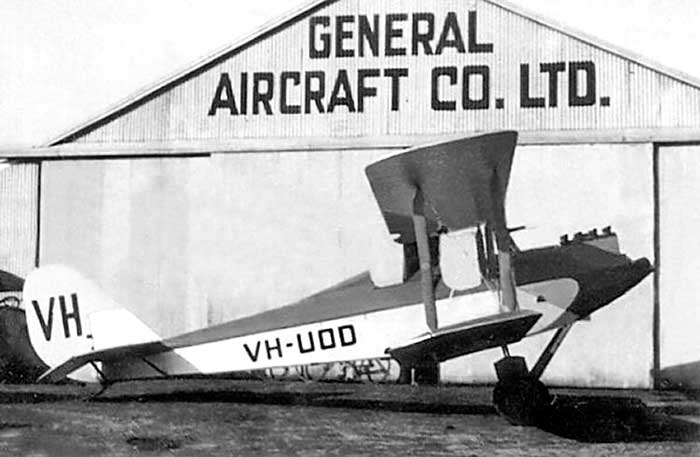
Photo: GAC via Ed Coates Collection
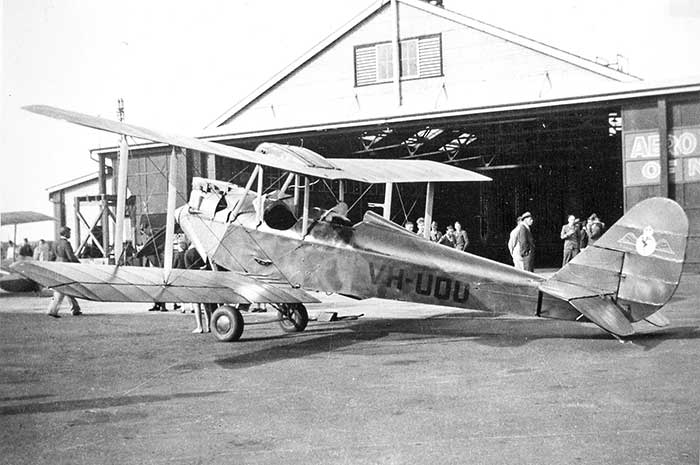
Frank Walters collection
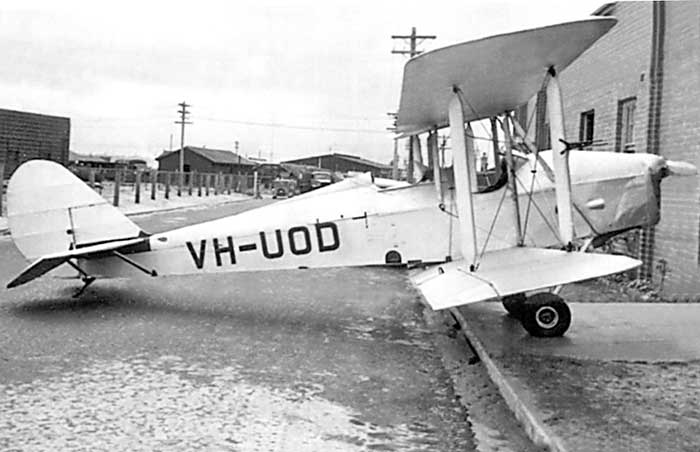
Photo by Ed Coates
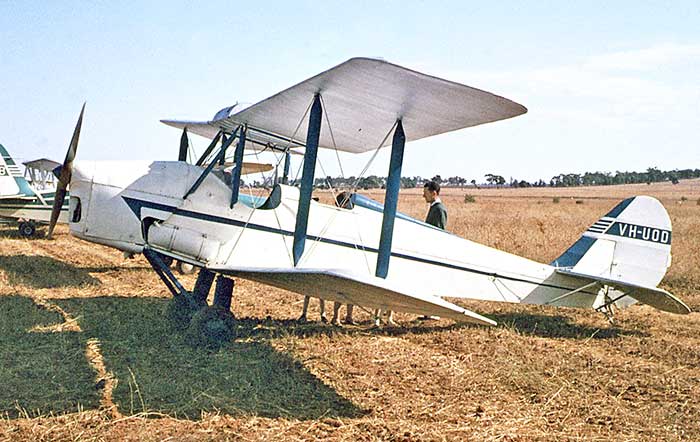
Photo by Bob Neate
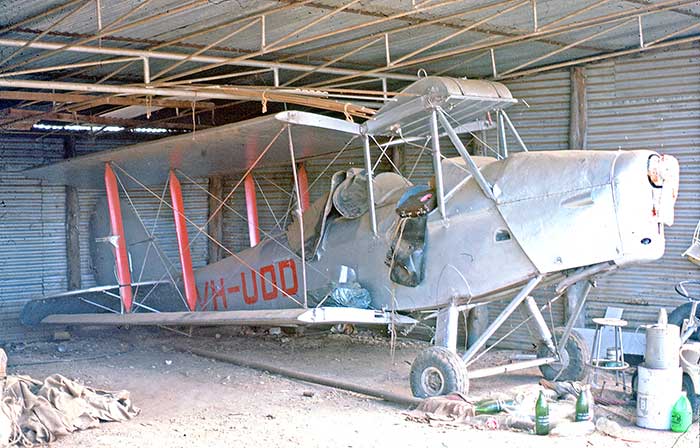
The paintwork was now much more appropriate to her age. Photo by Geoff Goodall
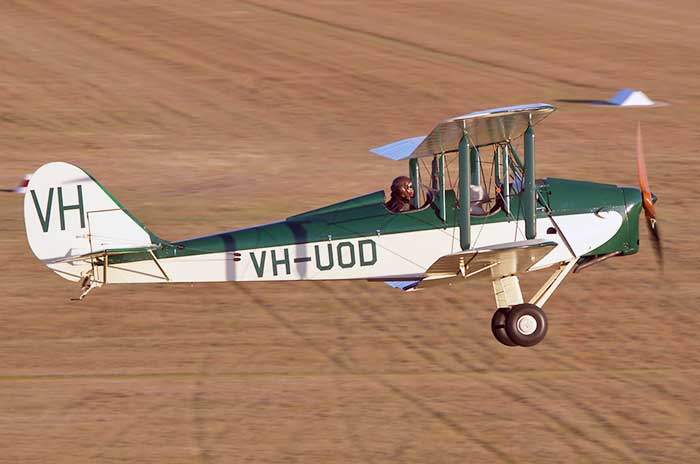
Back in the air again after a 7 year restoration at Caboolture Qld by Charlie Morris.
This superb Phil Vabre photograph shows Charlie departing Bundaberg Qld in August 2011.
This superb Phil Vabre photograph shows Charlie departing Bundaberg Qld in August 2011.
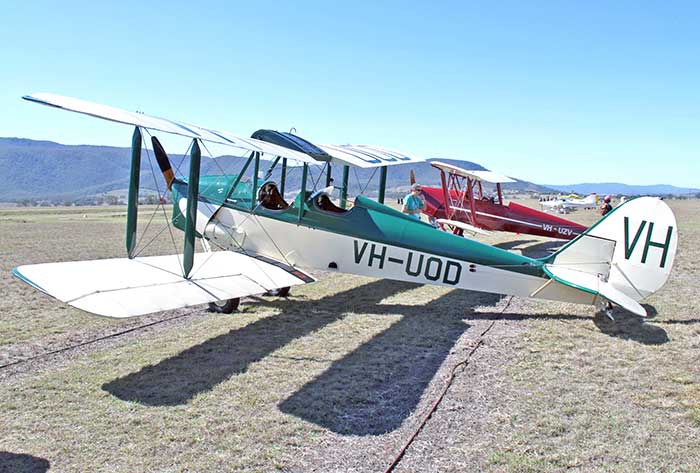
2014 annual fly-in at Watts Bridge, Queensland. Photo by Ian O'Donell
| 30 | Built by General Aircraft Co Ltd in their hangar at Mascot Aerodrome, Sydney NSW Completed with two open cockpits, fitted with a 105hp Cirrus Hermes Mk.II |
| 2.6.30 | Added to Civil Register VH-UOF: General Aircraft Co Ltd, Cook Street, Mascot Aerodrome |
| 7.30 |
CAB memo: Genairco c/n 15 has been completed. It is planned to be used
for an attempted record breaking flight to England scheduled to depart
Sydney early August 1930 |
| Additional
87 gallon fuel tank in the front cockpit installed by GAC. Based on
L.J. Wackett's calculations, CAB agreed to issue the CofA at the 640
pounds higher All-Up Weight of the full extrra fuel tank | |
| 28.7.30 | First flight Mascot, pilot L. H. Holden |
| 29.7.30 | Change of ownership: Andrew T. Cunningham, Queanbeyan NSW |
| Andy
Cunningham was a grazier at Tharwa ACT, just outside Canberra. To
promote his record flight, a Sydney newspaper named him "The Mystery
Pilot" and he wore a mask in public. When he flew at Mascot he used a nom-de-plume of "F. Jackson". Compiler's note: this deliberate confusion resulted in the ownership of VH-UOF being originally recorded by the Civil Aviation Branch in the hand-written Civil Aircraft Register ledger as "owner A. T. Cunningham, operated by F. Jackson". The reference to F.Jackson was later crossed out. | |
| 31.7.30 | VH-UOF departed Mascot at the start of the flight to Great Britain, flown by Cunningham |
| 5.8.30 | Forced landing at Boleng near Flores, Timor when the engine magneto drive failed. Delayed here while parts were shipped and installed |
| 14.9.30 | Forced landing at Singapore |
| 3.10.30 | Forced
landing at Myedone, Burma. The replacement engine failed when the
magneto-drive coupling sheared. The record flight was abandoned. |
| Cunningham made his way to Colombo where he departed on 18 October 1930 by ship to Sydney | |
| 3.1.31 | CAB write to owner A.T.Cunningham now in Fiji, asking if he will be repairing VH-UOF. He replied on 15.1.31 stating that the Genairco is stored in a shed at Akyab, Burma. He will arrange to have it returned to Sydney |
| 1.31 | VH-UOF departed Akyab on return flight to Australia. Pilot not identified Reached Flores, Timor, but the aircraft required another replacement engine and repairs. Owner decided it have it shipped to Sydney |
| Dismantled in a paddy field for shipping Timor to Sydney. Shipping delays resulted in the aircraft not reaching Sydney until May-June the following year | |
| 27.7.31 | Struck-off Register |
| 5.32 | Arrived Sydney by ship from Timor |
| .32 | Acquired by General Aircraft Co Ltd, Cook Street, Mascot Aerodrome NSW |
| 32 | General
Aircraft Co commenced an overhaul of the airframe which had
deteriorated during two years in the tropical climates of Burma and then Timor. While recovering the lower wing, GAC engineer Bob Pearce found a serious split in the woodwork of a lower main spar. A new spar was being constructed but two beetle borer holes was discovered in the original spar, obviously acquired during the paddy field in Timor. |
| GAC decided that little of the original aiframe could be used because
of concern over further tropical beetle infestation. This added
significant cost to the rebuild. GAC decided that the increased cost
made the rebuild uneconomical, so it was abandoned and the airframe
stored. | |
| 3.33 | Sold unrestored by GAC to G. A. Robinson, Sydney NSW Robinson was Manging Director of New England Airways, Lismore NSW which flew Avro 10s on airline services betwen Sydney and Briisbane. At this stage of The Depression, valuable additional income was generated by giving joyrides. It is assumed that the damaged VH-UOF was acquired for this purpose. The company later became Airlines of Australia. |
| 15.3.33 | CAB memo: VH-UOF is stored in the CAB hangar at Mascot Aerodrome. Robinson does not wish to register the aircraft until it is reconditioned |
| Stored | |
| 34 | Rebuilt by Tugan Aircraft Ltd, which had taken over the General Aircraft Co hangar at Mascot. Tugan described it as a "major reconstruction" |
| 2.8.34 | Construction date by Tugan Aircraft Ltd |
| 3.8.34 | Test flown
Mascot by pilot J.C. Carpenter, after rebuild by Tugan engineers L.Turl
and G.Beohm. Hermes II engine Airframe total time: 62 hours |
| 17.8.34 | Registration application: Tugan Aircraft Ltd, Mascot Aerodrome, Sydney. Signed by L. Turl |
| 20.8.34 | CofA renewed |
| 20.8.34 | Restored to Register VH-UOF: Tugan Aircraft Ltd, Mascot Aerodrome, Sydney |
| 19.2.35 | Change of ownership: H. C. B. Blythman, Sydney NSW |
| 21.2.35 | Damaged
in a forced landing in a forest near Warnervale NSW when engine failed
due fuel pipe ruptured while cruising at 3,000 feet. Pilot Goya Henry
unhurt, passenger minor injuries |
| ` | Repaired at Mascot by De Havilland Aircraft Pty Ltd |
| 15.4.35 | Test flown Mascot after repair by DHA manager A.Murray-Jones |
| 28.2.36 | Change of ownership: Sydney Hugh De Kantzow, Sydney NSW Sid De Kantzow had been a pioneer airline pilot in New Guinea. After importing Cierva Autogiros to Australia with partner Charles Gatenby, he joined management of Australian National Airways and immediately after WWII became a foundation partner in the formation of Cathay Pacific Airways, Hong Kong. The title of Charles H. Eather's book on Cathay Pacific "Sid's Pirates" acknowledges De Kantzow's role in the airline's early days. |
| 13.3.36 | Struck a cow while operating at Belmont Common aerodrome, Geelong Vic. |
| 5.36 | Repairs completed at Essendon Aerodrome, Melbourne by Hart Aircraft Service |
| 20.6.36 | Testflown Essendon after CofA renewal overhaul, pilot Charles Gatenby |
| 7.36 | Gatenby
flew De Kantzow's Cierva C.30 VH-USQ to Sydney as part of an "air
circus" with the Genairco flown by Sid deKantzow, and a DH.60 Moth |
| 25.7.36 | Forced
landing without damage at Alexandria Canal NSW. Pilot D. F. McMaster of
Qantas Empire Airways. Aircraft signed out that day by ground engineer
Charles Gatenby |
| 25.4.37 | Major damage when crashed after takeoff at Mascot Aerodrome due fuel starvation. Pilot J. C. Carpenter and 3 passengers received minor injuries |
| 6.8.37 | Testflown Mascot after repair, pilot S. De Kantzow |
| 12.1.38 | Change of ownership: Julius Gardner Pty Ltd, Sydney NSW Mr. De Kantzow has been employed as pilot instructor |
| 38 | Leased to Canberra Aero Club, Canberra ACT |
| 24.3.39 | Change of ownership: Macquarie Grove Flying and Glider School Pty Ltd, Camden NSW This thriving prewar flying club was estabished in 1937 by Edward Macarthur-Oslow at an airstrip on family land, offering training in a country club atmosphere. The Macarthur-Onslow family were Australian wool industry pioneers, the family had been active in aviation since 1924. An associated company Light Aircraft Pty Ltd was founded in 1937 by Denzil Macarthur-Onslow to import British aircraft and establish local manufacture of parachutes. MGF&GS operated three Genircos VH-UOD, UOF, UOG plus held wreck of VH-UOS |
| 22.3.40 | CofA expired. Due to
the war situation, RAAF had requisitioned the Camden airfield from the
Macarthur Onslow family to establish a new base for Central Flying
School |
| 3.40 | DCA
memo: VH-UOF is stored at Camden without engine. The owners
have purchased the Siemens Halske radial engine previously installed in
Genairco VH-UOS from Mr. Rollands at Noumea, New Caledonia. The Siemens
has not been used since VH-UOS was damaged in New Caledonia in 1931 and
is currently in the workshop of WHK Aero Engineering (W.H. Kuhl) at
Mascot Aerodrome |
| No further references to the re-engining proposal | |
| 9.45 | DCA memo: Lt Col Edward Macarthur-Onslow has just returned from overseas wartime service.
He will soon advise on his plans for the Macquarie Grove Flying School
which ceased operations in 1940 when RAAF requisitioned their airfield
and facilities. |
| 18.9.45 | Change of owner's name: Edward Macarthur Onslow, Camden NSW |
| 10.45 | Edward Macarthur-Onslow advises DCA that the flying school will be re-established |
| 2.4.47 | Edward Macarthur-Onslow wrote to DCA in response to a request on
status of VH-UOF, advising that the aircraft had been destroyed |
| Unconfirmed report that the stored airframe was in poor condition and was burnt | |
| 30.4.47 | Struck-off Civil Register as destroyed |
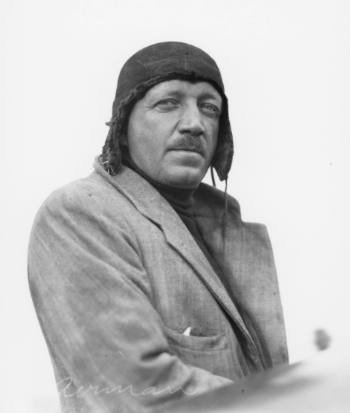
(Civil Aviation Historical Society collection)
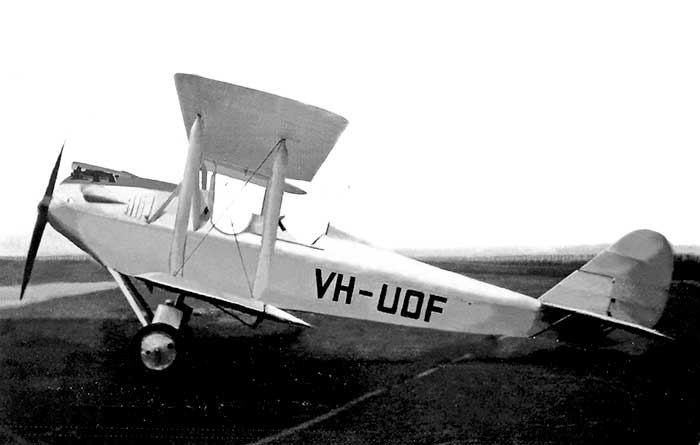
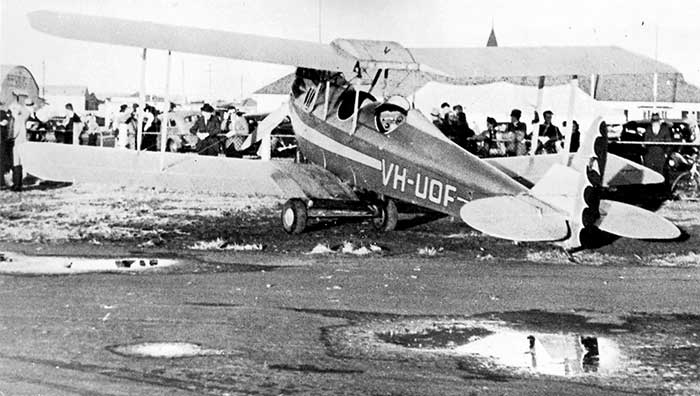
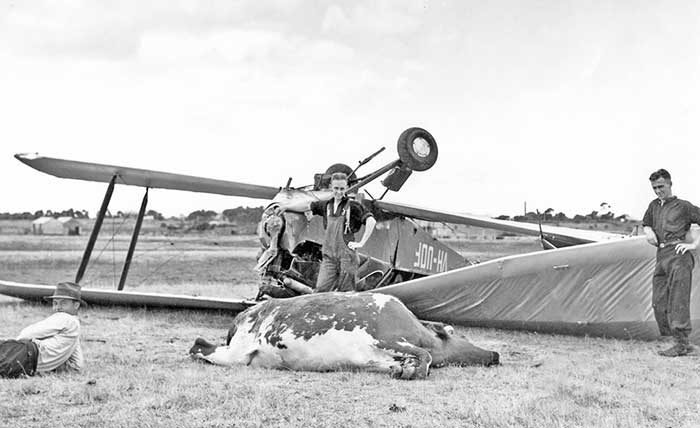
Photo by Charles D. Pratt via John Hopton Collection
| 28.5.30 | Construction date by General Aircraft Co Ltd in their hangar at Mascot Aerodrome, Sydney. Fitted with the second prototype 110hp Harkness Hornet engine with the radiator mounted under the rear of the engine bay. |
| The Hornet engine was
designed and built by Harkness & Hillier Engineering Co, Sydney
after consultation between Managing Director Don Harkness and Edgar W.
Percival on requirements for a new range of aero engines in the 70-110
hp category. The Hornet was a 4 cylinder, water-cooled engine. This second prototype had undergone extensive ground testing and the CAB testing schedule now required it to be fitted to an aircraft and flown for a minimum of 50 hours. | |
| 31.5.30 | Registration Application: General Aircraft Co Ltd, Mascot. Application signed by A.A.Royal |
| 2.6.30 | Added to Civil Regiser VH-UOG: General Aircraft Co Ltd, Mascot Aerodrome, Sydney |
| 1.9.30 | CAB memo: VH-UOG nearly complete, VH-UOH & UOI (stet) are still being constructed |
| 19.10.30 | First flight Mascot, pilot E. W. (Bill) Leggatt, CFI of the Aero Club of NSW |
| 5.11.30 | CofA issued |
| VH-UOG
flew 50 hours of testing the Harkness Hornet engine. Its performance
was considered successful but the weight of the engine and its radiator
system signifcantly reduced the payload. | |
| 20.11.30 | Test flying at Mascot with the Hornet engine, by Captain E.W.Leggatt |
| 1.31 | As
part of the agreement with the syndicate financing the Hawkness Hornet
engine, the trial engine was removed from the Genairco and returned to
the manufacturer for tear-down and internal inspection |
| 1.31 | GAC replaced the Hornet with an upright 130hp DH Gipsy Mk.II |
| 23.1.31 | Test flight Mascot by A.W. Gregory, after engine changed to Gipsy II |
| 23.1.31 | Change of ownership: Sidney C. Coleman t/a Coleman Air Service, Coleman's Garage. Bourke NSW |
| 24.2.31 | Overturned when struck an earth roller during landing at Bourke NSW. Pilot S. C. Coleman was being instructed by A.W. Gregory. |
| Damaged
aircraft sent to Mascot for repair by General Aircraft Co. The original
undercarriage shock-absorbers (similar to the Avro 504 type) were
replaced by DH.60 oleos and balloon tyres. This lowered the aircraft by 5 inches and improved the landing characteristics | |
| 24.3.31 | Test flown Mascot after repair, pilot A. W. Gregory |
| 4.10.35 | Change of ownership: Dr. T. J. Henry, Sydney NSW Flown by his son H. Goya Henry, who was a flamboyant joyride operator, well-known for his skirmishes with officialdom and his artificial leg as a result of a crash in Junkers Junior VH-UNO at Manly, Sydney in July 1930. |
| 15.1.36 | While being taxied by Goya Henry at Mascot, VH-UOG struck Adastra Airways' DH.83 Fox Moth VH-UQU. Minor damage to both aircraft. |
| 22.10.36 | Inspection report: total flying time 963 hrs 15 mins |
| 10.11.36 | High
Court of Australia upheld a constitutional appeal by Goya Henry against
his conviction and £1 fine on a charge brought against him by CAB for
ignoring circuit requirements while joyriding at Mascot on 30.9.34. Henry challenged the validity of CAB regulations on a State vs Federal basis. The "Henry Case" caused wide-ranging changes to Federal and State law, the disbandment of the Civil Aviation Branch, its regulations and licencing, and a Federal Referendum. A new Department of Civil Aviation was established in 1937 with Air Navigation Regulations enforced by appropriate State Air Navigation Acts. This allowed DCA to cancel Goya Henry's commercial pilot licence in 1938 by which time he had flown another 1500 hours since his original court case. |
| 27.12.37 | Overturned landing on a beach at Evans Head NSW while joy-riding. The wheels were struck by a wave. Pilot Goya Henry and 2 passengers not hurt |
| 2.4.38 | Damaged
in ground collision with BA Swallow VH-UUN at Mascot. Goya Henry in UOG
was commencing his takeoff run when he struck the Swallow, pilot
A.O'Hara |
| 3.39 | DCA memo: VH-UOG is in the Kingsford Smith Air Service hangar, waiting to be repaired |
| 40 | Moved to Camden airfield for rebuild by the Macquarie Grove Flying and Glider School Pty Ltd. The work was almost completed when the company had to cease operations when the RAAF took over their airfield |
| 2.10.40 | Change of ownership: H. Goya Henry, Sydney NSW. Inherited from his father's estate. |
| 18.12.40 | Test flown at Mascot after repairs were completed, pilot Goya Henry |
| 18.12.40 | CofA renewed |
| 17.12.41 | CofA expired. Not renewed by Henry due wartime restrictions on fuel for private flying |
| Stored for the duration of WWII | |
| 28.2.45 | Public auction by
auctioneer G. Christey on the vacant lot next to the Christey's Motor
Auctions rooms on Broadway, Sydney. Advertising for the auction stated
that Goya Henry had flown this aircraft under the Sydney Harbour Bridge. The aircraft was parked, fully assembled, still painted in Goya Henry's well-known vivid red scheme with name Jolly Roger. Henry ran up the engine to encourage the bidders. |
| 28.2.45 | Knocked down to the highest bidder at £390 to J. Griffiths, Melbourne Vic Griffiths was a RAAF airframe fitter soon to be demobbed, however the sale was not finalised |
| 15.8.46 | Change of ownership: Macquarie Grove Flying and Glider School Pty Ltd, Camden NSW c/- Edward Macarthur-Onslow This thriving prewar flying club which owned Genaircos VH-UOD & VH-UOF was re-estabished after WWII when the RAAF handed the Camden airfield which was on family property. It had been requisitioned in 1940 as a base for Central Flying School. The wartime military hangars and numerous dormitory blocks and classrooms were now used by the rejuvinated flying school offering a live-in country-club atmosphere. Expanded postwar ventures included purchase of ex-RAAF Hudson bombers for civil conversion at Camden. |
| 6.2.47 | CofA renewed. Company name changed to Macquarie Grove Flying School Pty Ltd, Camden |
| 10.2.48 | Annual CofA renewal at Camden in the workshops of MGFS |
| 9.2.49 | CofA expired, not renewed |
| 6.8.51 | Struck-off Register in DCA Census of unairworthy aircraft |
| 9.51 | Macquarie
Grove Flying School wrote to DCA advising that they had sold DH.60M
Moth and Genairco VH-UOG to Bill Campbell-Hicks, Conbobolin NSW |
| 51 | VH-UOG commenced an extended overhaul by J.S.McConnell & Sons to renew CofA |
| 6.2.52 | Test flight. CofA renewed |
| 6.2.52 | Restored to Register: William Campbell-Hicks, Conbobolin NSW |
| 14.4.52 | Change of ownership: Lance Berryman, 'Mountauban", Tottenham NSW |
| 20.1.56 | Change of ownership: Oscar G. Roche, Tottenham NSW. Still fitted with upright Gipsy II engine. |
| At some stage VH-UOG was fitted with a straight-axle undercarriage and wheels from a DH.82 Tiger Moth | |
| 24.1.64 | Struck-off Register as withdrawn from service. |
| .67 | Joe Drage of Albury NSW commenced negotiations with Oscar Roche to acquire VH-UOG. Drage had owned Genairco Cabin VH-UUI, which he sold to USA in 1966 to finance his planned vintage aircraft museum with emphasis on Australian-built types. |
| VH-UOG was stored in a hangar at Tottenham airfield, with wings folded. Roche also owned Genairco VH-UOD which was stored at his house in the town of Tottenham, also with wings folded | |
| Drage agreed to rebuild the wings of Roche's Genairco VH-UOD in exchange for VH-UOG. | |
| 12.4.69 | VH-UOG sold to Joseph G. Drage/ Drage Historic Aircraft Museum, Wodonga Vic Moved to Joe Drage's farm at Wodonga and displayed in his large purpose-built hangar for the vintage aircraft collection |
| 5.5.73 | UOG noted at Wodonga in museum hangar. All silver with red interplane struts |
| 81 | Flying from the Drage farm
airstrip had been restricted due to conflict with instrument approach
procedures at the nearby Albury Airport. Some of Drage's
airworthy aircraft were based at Albury Airport while he attempted to
finda new location for his collection |
| 84 | Joe
Drage negotiated with the City of Wangaratta for a proposed new
aviation museum at their new airport. A largo igloo hangar was
constructed painted as AIR WORLD. His collection of vintage aircraft would be displayed there. A modern interstate bus terminal was included, with a large cafeteria for bus passengers |
| 1.85 | VH-UOG transported from the Wodonga farm museum site to the new Airworld, Wangatta Vic. 8 airworthy aircraft were flown in on 27.1.85, the others moved by road |
| 3.4.85 | Ownership transferred to City of Wangaratta, Wangaratta Vic |
| 1.02 | Air World closed due to falling revenues |
| 8.2.02 | VH-UOG noted in the Air World hangar while waiting disposal |
| 8.03 | Advertised for sale with remaining Air World aircraft: VH-UOG TT 1362 hrs, asking $60K |
| 14.5.04 | Restored to Register VH-UOG: Dr Robert (Roy) Fox, Kellyville NSW. |
| 1.7.07 | Acquired by Museum of Applied Arts and Sciences, Powerhouse Museum, Sydney |
| Displayed at Museums Discovery Centre, Castle Hill, Sydney |
|
| Current |
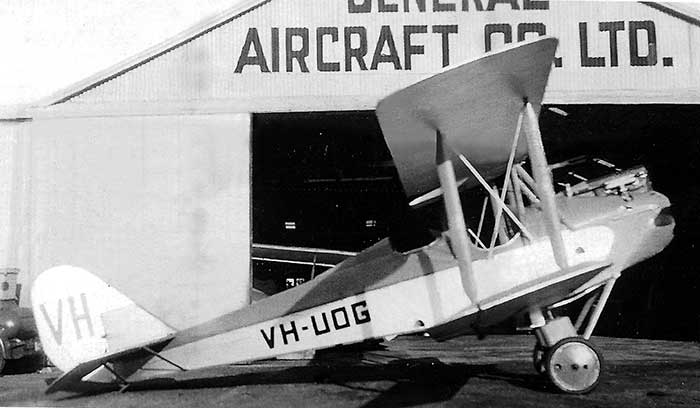
below the engine bay between the undercarriage legs. GAC via Ed Coates collection
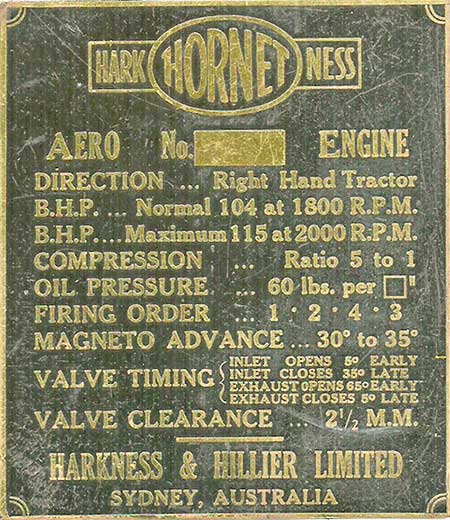
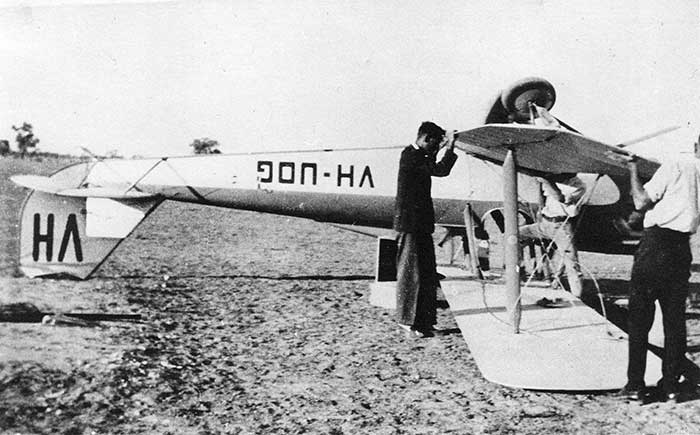
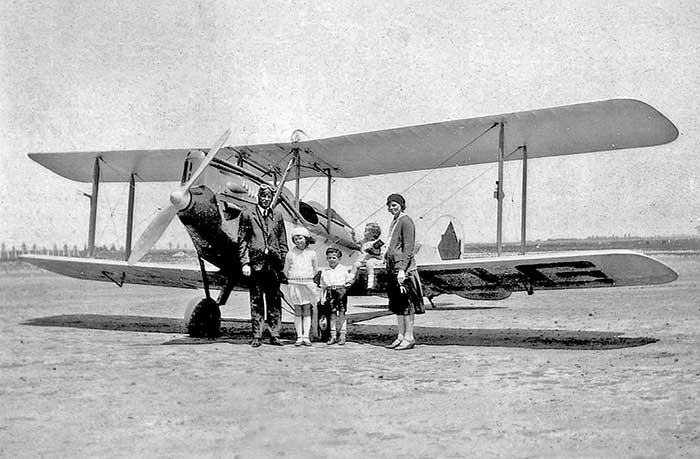
at Bourke circa 1931. Photo courtesy Dana Jennings
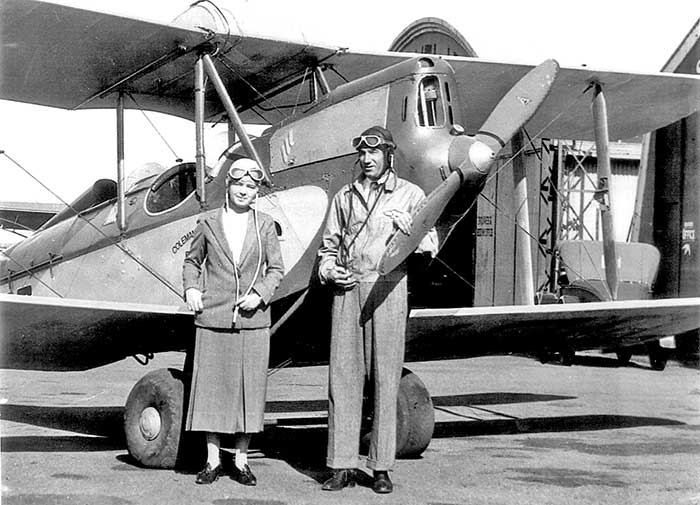
VH-UOG at Mascot with Gipsy II engine, balloon tyres and "Coleman Air Service" on the fuselage.
Sid Coleman with nurse Sister Hilda Brooks, who he flew many times from Bourke on medical visits
to remote properties and towns in far western NSW. Photo courtesy Dana Jennings
Sid Coleman with nurse Sister Hilda Brooks, who he flew many times from Bourke on medical visits
to remote properties and towns in far western NSW. Photo courtesy Dana Jennings
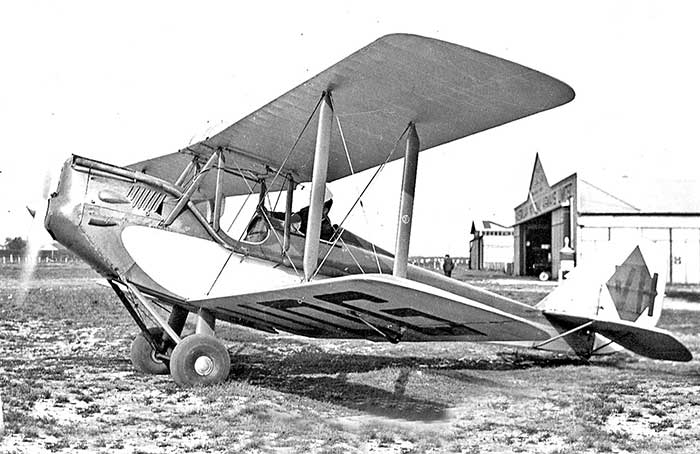
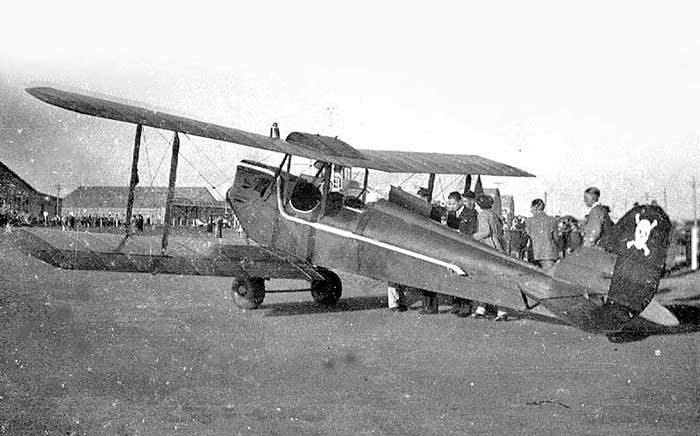
on the rudder and the name "Jolly Roger" on the nose. Frank Walters collection
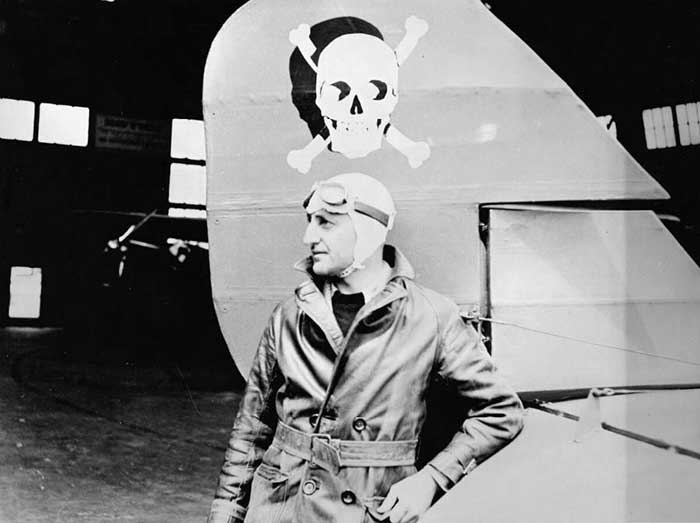
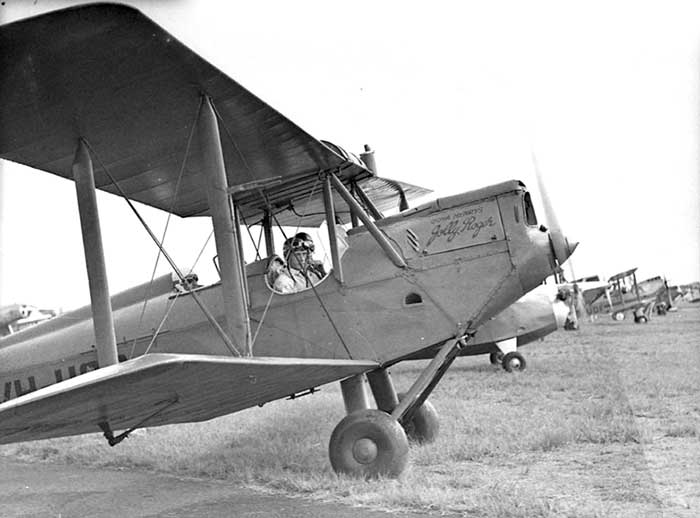
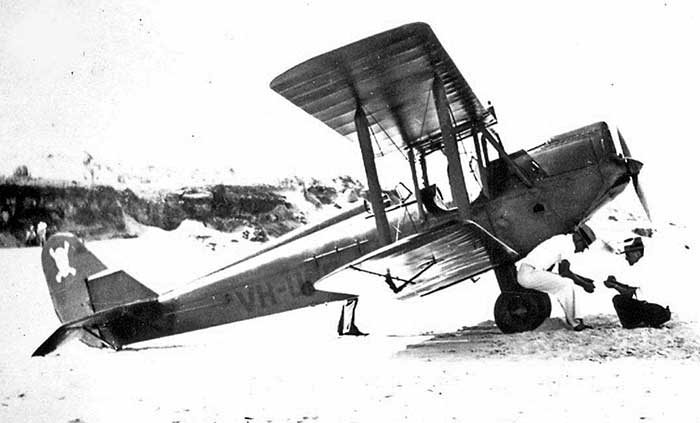
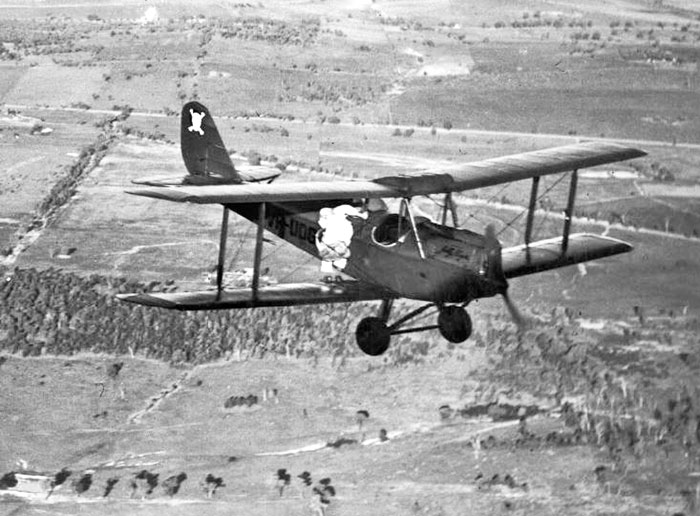
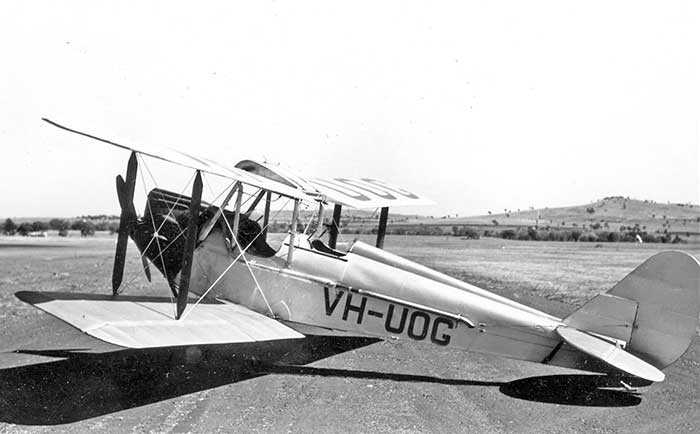
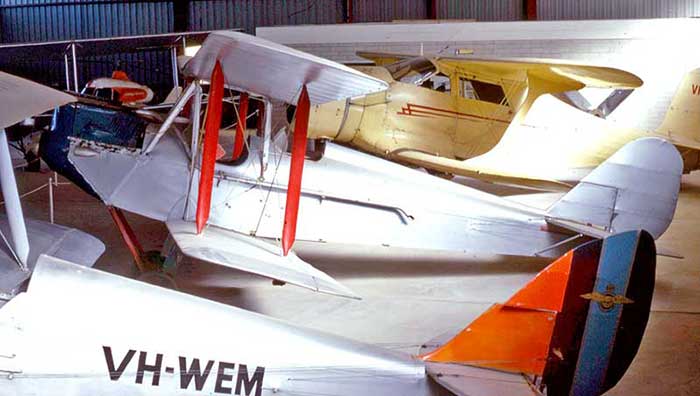
The engine is an upright DH Gipsy II. Photo by Geoff Goodall
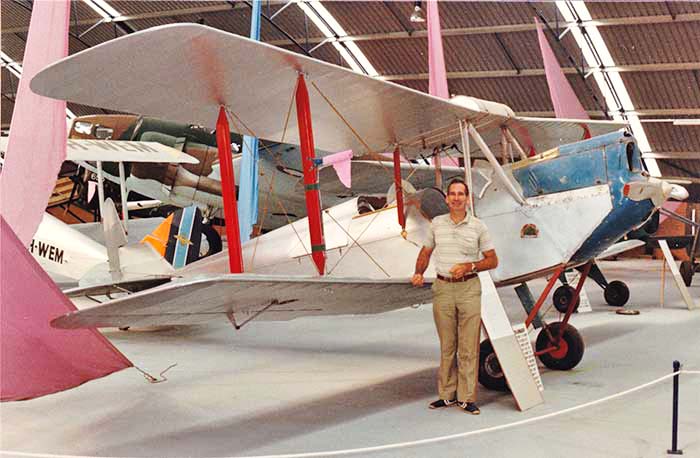
a relative of the Genairco's former colourful owner Goya Henry. Photo Warwick J. Henry
| 30 | Built by General Aircraft Co Ltd in their hangar at Mascot Aerodrome, Sydney NSW Completed with two open cockpits, fitted with a 115hp Cirrus Hermes Mk.II |
| 2.6.30 | Added to Civil Register VH-UOH: General Aircraft Co Ltd, Mascot Aerodrome, Sydney |
| 32 | Prospective sale of two floatplane Genaircos to a new company in Fiji. Aeronautical engineer Lawrence J. Wackett was commissioned to design light-weight wooden floats for both aircraft. |
| 17.5.32 | Test flown Sydney fitted with floats |
| Sold to Fiji Airways Co Ltd, Suva | |
| 2.2.33 | Floatplanes VH-UOH & VH-UOJ were shipped from Sydney as cargo on board RMS Aorangi bound for Suva, Fiji. They were accompanied by J. G. Beohm of GAC who had joined Fiji Airways Ltd as their ground engineer. |
| 4.5.33 | Struck-off Australian Register as sold to Fiji |
| 23.3.33 | Registered VQ-FAC: Fiji Airways Co Ltd, Suva Fiji. Fitted with floats |
| 22.5.33 | Sank in Suva Harbour. The floatplane was undergoing flight-tests ordered by the Governor of Fiji. There was no aviation authority responsible for Fiji, so two Public Works Department engineers were instructed to ride in the front two-passenger open cockpit, in order to certify that they the aircraft was airworthy. However sand-bags ballast which had been loaded for earlier test flights was not removed. The total weight of pilot, 2 passengers plus ballast was too heavy for the floats. When pilot Gordon Fenton throttled back after applying power to water-taxy out in the harbour, the floats were submerged and the aircraft tipped on its side and sank. No injuries. |
| 5.33 | Badly damaged while being salvaged in Suva Harbour |
| Unconfirmed whether it was repaired in Fiji. It has been reported that George Beohm rebuilt this aircraft in Fiji as a Genairco Cabin, but that seems doubtful. | |
| 2.34 | Fiji Airways stopped flying |
| 3.3.34 | Fiji Airways Ltd officially ceased operations and was liquidated |
| 3.34 | Genaircos VQ-FAC & VQ-FAD shipped from Fiji to Sydney |
| 8.4.34 | VQ-FAC & VQ-FAD arrived at Mascot |
| Both rebuilt at Mascot | |
| 24.9.36 | Restored to Australian Register as VH-UUI: Walter H. Kuhl & Albert H.P. Lewis, trading as Airflite Pty Ltd, Mascot Aerodrome, Sydney Airflite became a very active pre-war company at Mascot, with a flying school, aircraft hire and a full range of mainttenance. Airflite also gained agencies for American manufacturers, importing and assembling Ryan ST-A, Aeroncas etc. The company ceased operations for the duration of the war. |
| 24.9.36 | VH-UUI CofA renewed as a Genairco Cabin landplane, Cirrus Hermes Mk.II. |
| 9.36 | Owners Kuhl and Lewis respond to a CAB enquiry that cabin fitted for 2 passengers only |
| 17.4.39 | Change of ownership: C. S. Hill, Charters Towers Qld Operated with North Western Air Charter Services titles on tail |
| 8.1.40 | Inspection report: total airframe time: 778 hrs 40 mins. An Airchief car radio had been installed by Amalgamated Wireless Australia |
| 2.40 | Original main undercarriage replaced by DH.60 type by De Havilland Aircraft Pty Ltd at Mascot |
| 26.3.40 | Crashed during a night landing at Townsville Qld |
| .40 | Damaged aircraft despatched from Townsville to Sydney for rebuild by National Aircraft Pty Ltd at Mascot |
| by 2.41 | National Aircraft Pty Ltd were in liquidation |
| .41 | Repossessed by Walter H. Kuhl & Albert H.P. Lewis/ Airflite Pty Ltd, Mascot |
| Assumed stored for duration of war | |
| 30.6.44 | Register Change of ownership: Walter H. Kuhl & Albert H.P. Lewis t/a Airflite Pty Ltd, Mascot Aerodrome, Sydney |
| 21.6.46 | Change of ownership: W. H. Kuhl Aero Engineering Co, Mascot Aerodrome, Sydney |
| 24.2.47 | Change of ownership: L. P. Roberts, Sydney NSW |
| 19.6.47 | Change of ownership: Kenneth H. Johnson t/a Air Taxi Services of Australia, c/- Airflite Pty Ltd, Mascot Aerodrome, Sydney Johnson had purchased two RAAF disposals Avro Ansons which had civil conversion at Mascot by Marshall Airways to become VH-AZU and VH-AZX in January 1947. Both were sold in October 1947 to Brown & Dureau as agents for Far East Flying Training School, Hong Kong, along with Ryan STMs. However the Ansons were not exported and were taken over by Marshall Airways for monies owed. Air Taxi Services of Australia ceased operations in 1948 |
| 18.12.48 | Struck-off Register as withdrawn from service |
| 15.11.49 | Restored to Register: R. C. W. Mclean, Sydney NSW |
| 18.4.52 | Change of ownership: Reginald Geary t/a Sydney Air Taxi Co, Bankstown NSW Reg Geary operated a variety of aircraft for charter, including Percival Gull VH-BQA. DCA refused to renew Sydney Air Taxi Co's charter licence in 1956 due to unsatisfactory operations. |
| 10.8.52 | Damaged undercarriage and propeller landing at Penrith NSW |
| 15.9.52 | Change of ownership: Arnold J. Glass/ Australian Aviation Investments Pty Ltd, Sydney (Trade-in by Geary on Proctor VH-BQO, one of 4 imported from England by Arnold Glass) |
| Engine changed to 130hp DH Gipsy Major Mk.1 | |
| 20.11.53 | Delivered from Bankstown to Albury NSW to new owner L.G.Stewart |
| 23.11.53 | Change of ownership: Lindsay G. Stewart t/a Stewart's Albury Air Services Albury NSW |
| 27.1.54 | Annual CofA renewed at Albury by J. McInnerney Aviation Services, airframe time 1,096 hours |
| 4.3.55 | Annual CofA renewed at Albury by engineer Col Tobin. Also 4.3.56, 11.12.56, 11.9.58 |
| 10.9.59 | CofA expired, not renewed. Parked in hangar at Albury |
| 1.7.61 | Struck-off Register as withdrawn from service. Parked in a hangar at Albury airfield |
| 11.1.64 | noted at Albury in hangar, wings folded, all black with silver trim, covered with dust "Stewart's Albury Air Services"titles on fuselage sides |
| 25.9.64 | Change of ownership: Joseph G. Drage & James D. Steele, Albury NSW |
| 12.12.64 | CofA renewed at Albury after overhaul by Col Tobin, Gipsy Major 1. Repainted gloss grey with red trim. |
| 25.1.65 | Restored to Register as VH-UUI |
| 14.3.65 | visited Swan Hill Vic airshow, painted grey with red trim |
| 3.10.65 | local flying Albury, pilot Keith Meggs. |
| 5.66 | Sold to Keith Death, t/a Hazair Albury. |
| From the book Airmen I Have Met by Derrick Rolland, referring to Joe Drage: "Joe realised that many historic aircraft were being lost, through neglect or being sold overseas. He bought his first aircraft, a cabin Genairco VH-UUI, in 1964, but as he was short of money, Jim Steele, who was working for Joe, took a half share. Jim had been a fighter pilot in WWII. After restoration the aircraft was registered in January 1965, but was sold to Keith Death in May the following year. The Genairco had been purchased for £600 and sold for £800. As this aircraft was then sold to America, Joe then vowed he would not sell aircraft outside Australia". Drage went on to establish Drage Historic Aircraft Collection and later, Drage Air World. | |
| 5.66 | Undated Change of ownership form submitted to DCA: Hazair Sales & Service, Orange NSW |
| .66 | Export to USA was handled by Jim Hazelton/ Hazair Agricultural Services/ Hazair Sales and Service, Orange NSW. Jim Hazelton was an agricultural operator who specialised in importing used Cessnas and Pipers from USA for local resale. By 1966 he was importing significant numbers of used twin engined Pipers, ferrying some from USA himself. His US sales contacts were helpful to market the Genairco. |
| .66 | VH-UUI was flown from Albury to Bankstown Airport, Sydney where it was dismantled and packed for shipping to USA |
| .66 | Sold to Joe Meyers/ Nystrom Aviation Corporation, Palo Alto, California USA |
| 5.5.66 | Struck-off Australian Register as sold to USA |
| 6.66 | Assembled at Palo Alto airfield, California |
| 6.67 |
noted parked outside at Palo Alto airfield in Australian paint scheme as VH-UUI |
| 22.9.67 | Registered N240G Richard Sawyer, Aviation Centre Inc, San Jose California |
| 67 | Being refurbished at San Jose airport. Airframe total time: 1480 hrs 50 mins |
| 67-68 | Flying in California as VH-UUI |
| c70 | Purchased by Joseph L. Terteling, Boise Idaho Joe Terteling had a collection of over 40 antique aircraft and gliders, which he stored in hangars at Glider Field near Boise. He also had a large number of aero engines, instruments and parts. Most of the aircraft fell into poor condition in ramshackle hangars and by 1980s were dismantled, covered in dust with deteriorated fabric. |
| 20.9.86 | Joe Tertling Collection auction sale: "One of the World's Finest Aircraft Collections" 42 aircraft and large collections of aero engines, propellers, spare parts, aerial cameras, library of aircraft manufacturer handbooks, 3 rooms of parts: rivets, instruments,tubing, tyres etc. Auction Catalogue had a photograph of VH-UUI complete with wings folded, same paint scheme grey with red trim. Extensive fabric removal on wings, tail and forward fuselage. "1930 Genairco N240G s/n 17: engine Gipsy Major. Built in Australia. It features folding wings, an open pilot's cockpit and enclosed cabin for two passengers. Although it needs restoration, it is complete." |
| 20.9.86 | Sold at the Boise auction for $11,000 to Kermit A. Weeks, Miami, Florida Kermit
Weeks, head of Weeks Petroleum Inc, was a keen pilot who opened his Weeks
Air Museum at Tamiami Airport, Miami in March 1987. During visits to
Australia in connection with oil exploration and leases, Weeks
developed an interest in Australian aircraft and purchased a number of
Australian military and civil aircraft for his collection.
At the Boise auction he also purchased a 1916 Avro 504K for $95K |
| Held dismantled in long-term storage with other Weeks collection aircraft in storage building at Fantasy of Flight, Polk City, Florida. | |
| Current |
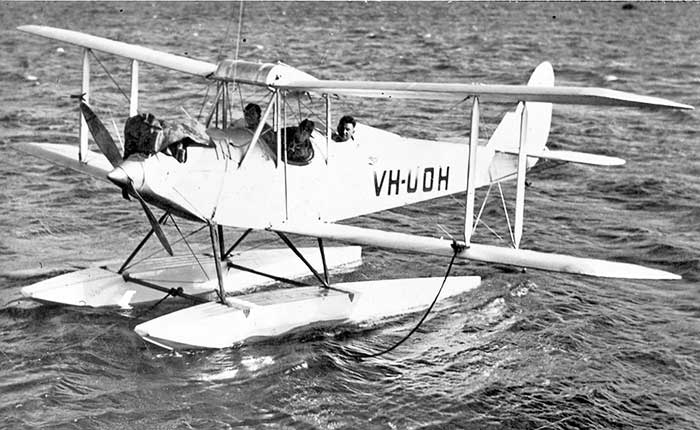
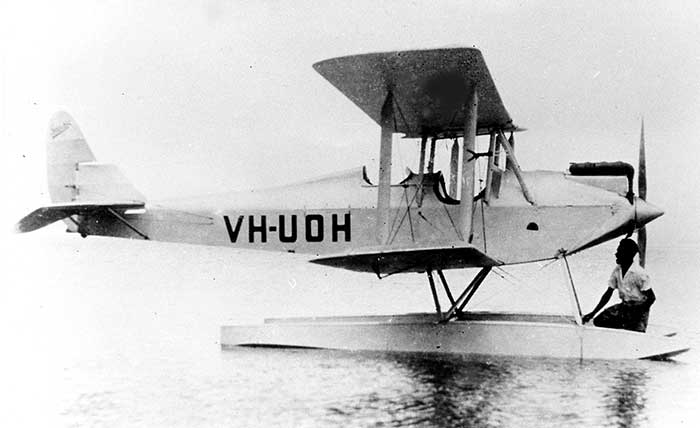
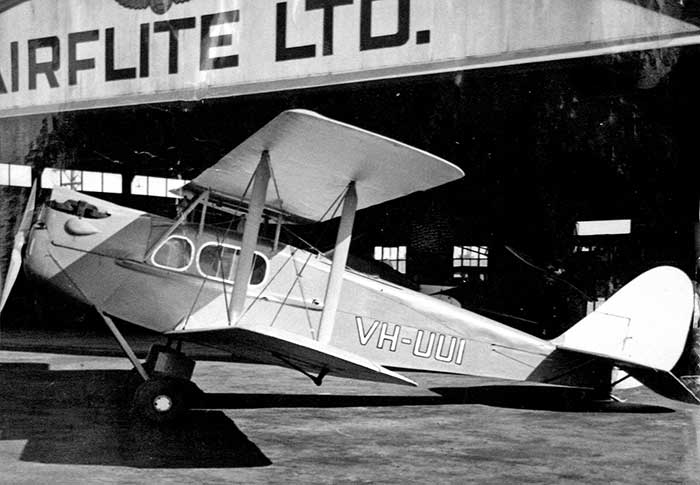
This photo was attached to the DCA CofA form. Courtesy Neil Follett
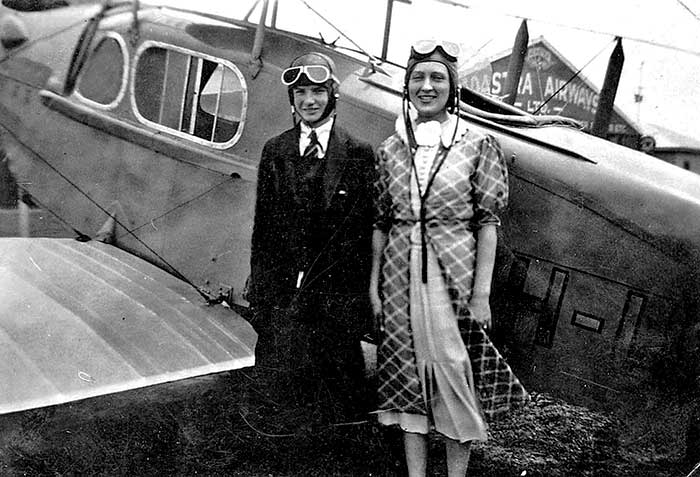
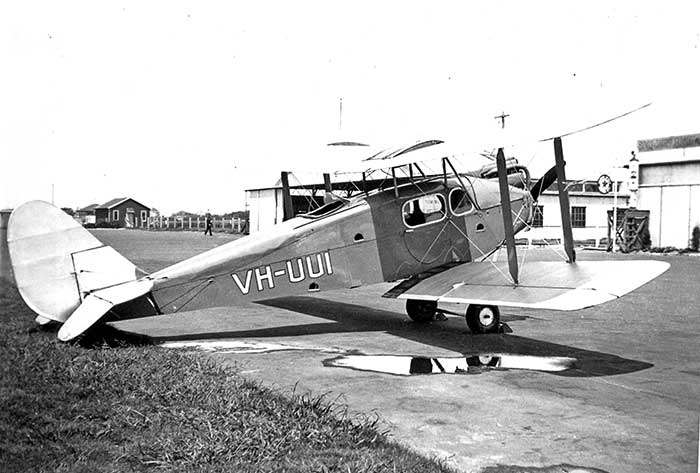
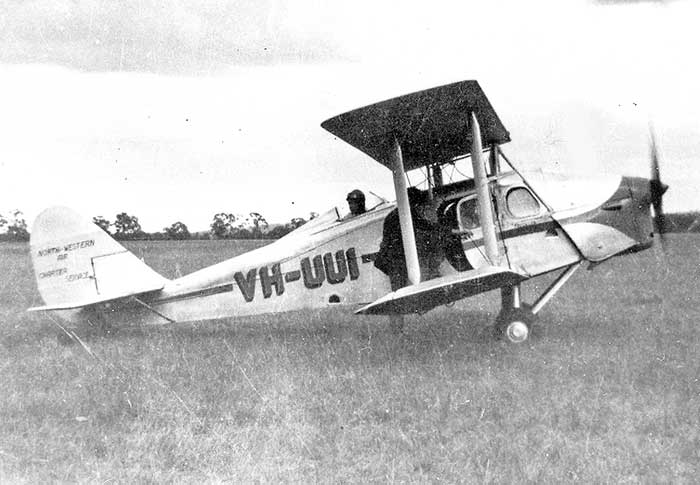
Frank Walters collection
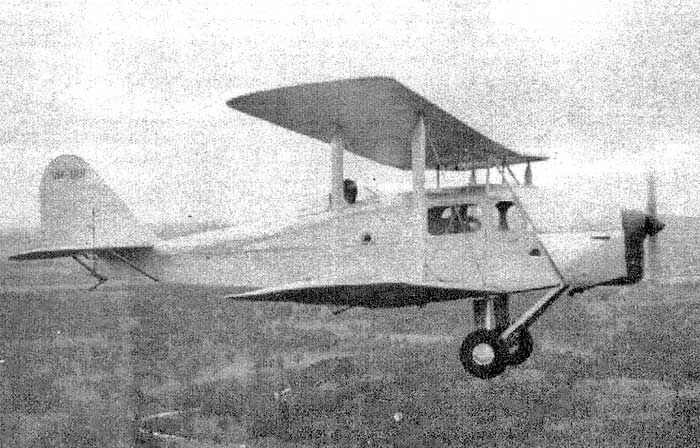
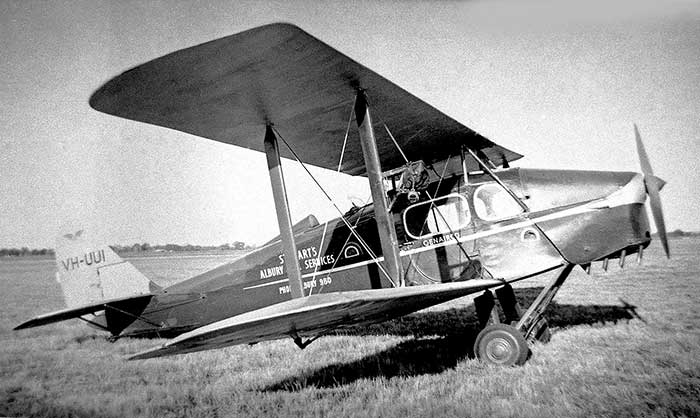
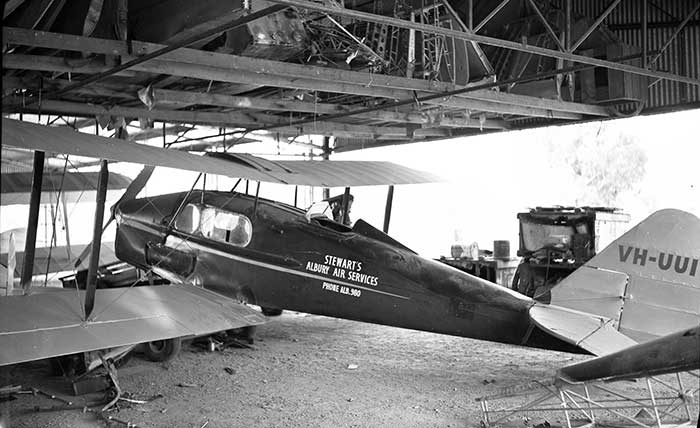
The Genairco was surrounded by a good collection of Tiger Moth frames Photo by John Hopton
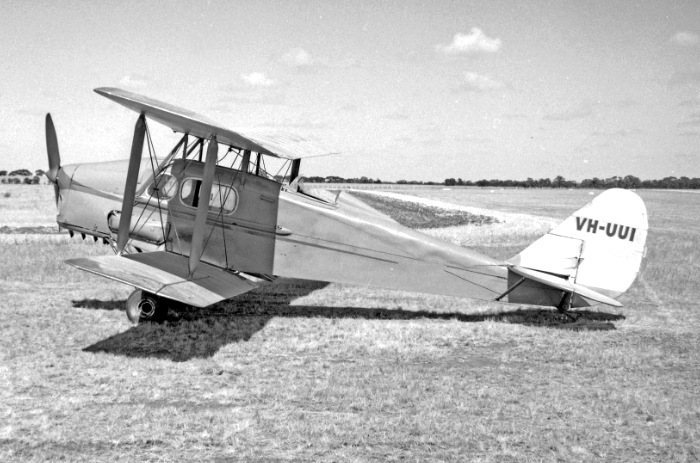
by new owners Joe Drage and Jim Steel. Photo by Geoff Goodall
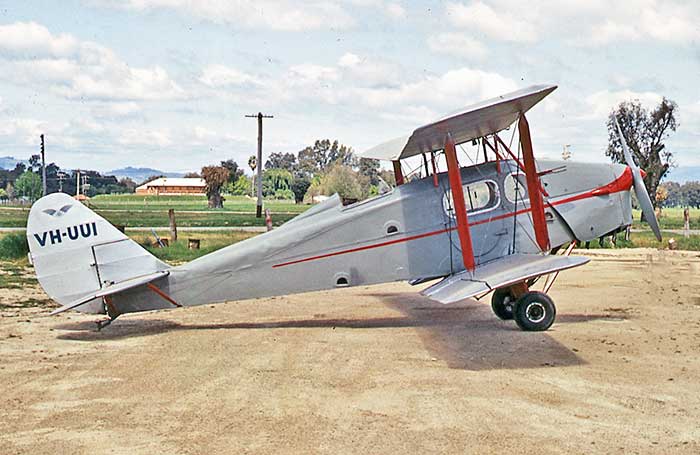
Six months later it was shipped to USA for an antique aircraft enthusiast. John Hopton Collection
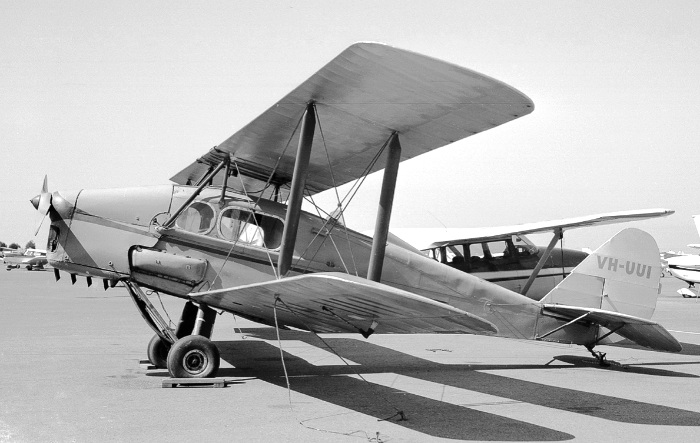
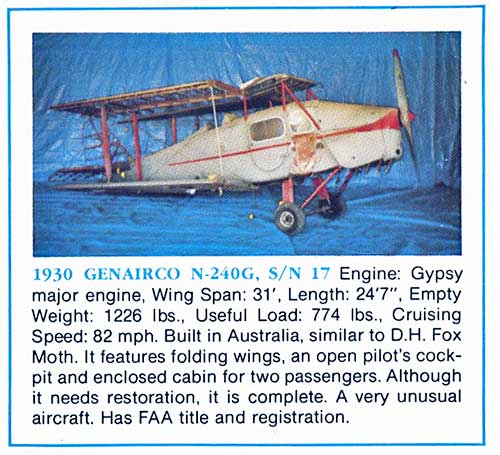
in Idaho on 20 September 1986. Extensive fabric removal is evident.
| 30 | Built by General Aircraft Co Ltd in their hangar at Mascot Aerodrome, Sydney NSW 105hp Cirrus Hermes Mk.II |
| 14.7.30 | Added to Civil Register VH-UOJ: General Aircraft Co Ltd, Cook Street, Mascot Aerodrome |
| No purchaser | |
| 13.7.31 | Struck-off Australian Register |
| 12.31 | GAC commenced work on modifying the unsold VH-UOJ to install an enclosed forward cabin with three passenger seats. Completed in June 1932 as the prototype Genairco Cabin model |
| 32 | Prospective sale of two floatplane Genaircos to a new company in Fiji. Aeronautical engineer Lawrence J. Wackett was commissioned to design light-weight wooden floats for both aircraft. |
| 30.6.32 | First test flight Mascot as a Genairco Cabin |
| 7.32 | Flight tests for CAB certification were flown by C.Arthur Butler with T.D.J. Leech as observer |
| 2.11.32 | Test flown Sydney fitted with floats |
| 7.11.32 | CAB issued a Provisional CofA for operation outside Australia |
| 2.2.33 | Floatplanes VH-UOH & VH-UOJ were shipped from Sydney as cargo on board RMS Aorangi
bound for Suva, Fiji. They were accompanied by J. G. Beohm of GAC
who had joined Fiji Airways Ltd as their ground engineer. VH-UOJ was painted as such, despite not having a cuurent Certificate of Registration |
| 18.3.33 | VH-UOJ flew inaugural Suva-Ellington-Lautoka weekly service. Captain C. Gordon Fenton |
| 21.3.33 | VH-UOJ flew inaugural Suva-Levuka-Lambasa weekly service. Captain C. G. Fenton |
| 23.3.33 | Registered VQ-FAD: Fiji Airways Ltd, Suva, Fiji |
| 30.3.33 | flew the inaugural fortnightly service Suva-Levuka-Taveuni, Captain C. G. Fenton |
| 33 | Damaged when it broke free from moorings |
| 5.33 | Following the sinking of VQ-FAC, a revised round service Suva-Ellington-Lautoka-Makogi- -Nabouwalu-Suva was maintained solely by Genairco Cabin VQ-FAD |
| 22.5.33 | Fiji Airways' standby
aircraft, Simmons Spartan 3-seater floatplane VQ-FAA overturned in
water while flown by Captain Fenton. The damaged Spartan was sold to General Aircraft Co Ltd, Sydney and VH-UUJ was reserved, but it was never registered in Australia. The Spartan's metal Fairchild floats and 115hp engine (type not quoted) were installed in Genairco VQ-FAD in Fiji |
| 2.34 | Air services discontinued |
| 3.3.34 | Fiji Airways Ltd ceased operations and was liquidated |
| 3.34 | Genaircos VQ-FAC & VQ-FAD shipped from Fiji to Sydney |
| 8.4.34 | VQ-FAC & VQ-FAD arrived at Mascot |
| 25.10.35 | Restored to Australian Register as VH-UUK: W. J. and J. M. Buckingham, Mascot Aerodrome, Sydney |
| 25.10.35 | CofA issued as a Genairco Cabin landplane with conventional undercarriage |
| 20.12.35 | Change of ownership: F. W. Barratt Wood, Melbourne Vic |
| 12.35 | CAB approved owner Wood's request to install floats. Installed at Mascot |
| 1.36 | Fitted as a floatplane, operated joyrides at Victorian coastal towns and Melbourne beaches |
| 10.2.36 | CAB suspended the CofA based on reports that the floats axle booms were seriously under strength |
| c2.36 | Wheels installed at Essendon by Matthews Aviation |
| 12.36 | Entered in the Brisbane-Adelaide Air Race, nominating pilot C.A.Mullholland, owner F. Barratt Wood. Withdrawn prior to the start. |
| 2.37 | Floats installed again, with modified booms, at Port Melbourne Vic. Returned to joyriding as a floatplane |
| 17.3.37 | Change of ownership: Douglas A. Collis, Seymour Vic |
| Continued joyriding in Melbourne area as a floatplane, flown by Jack "Tarzan" Fraser | |
| 5.37 | Owner Collis has VH-UUK in Cairns, Far North Queensland, preparing for a leisurely coastal holiday flight from Cairns to Melbourne, with pilot John W. Fraser |
| 5.37 | Re-fitted with floats at a boat ramp in Cairns Inlet |
| 12.6.37 | Destroyed by fire, emergency landing, Cairns Qld. Pilot John Fraser experienced a rough running engine soon after takeoff from Cairns Inlet, then became partially blinded by smoke. He made a forced landing in a mangrove swamp on the bank of Cairns Inlet, near No.6 Wharf. Fraser jumped into the water to escape the burning aircraft which was burnt out. |
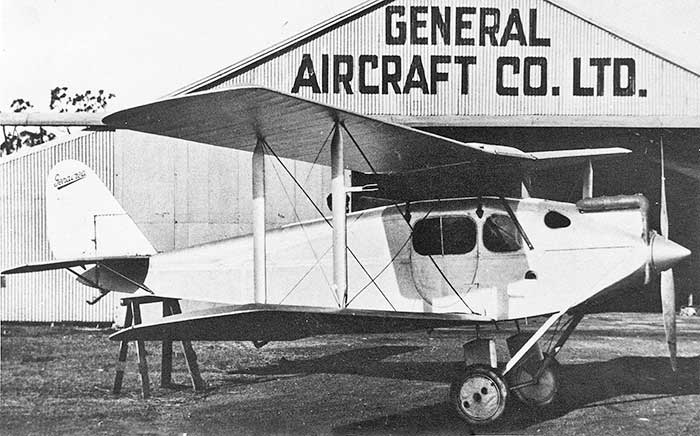
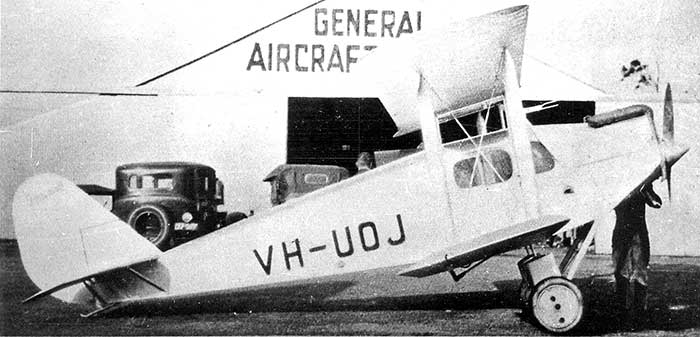
Photo: Genairco via Frank Walters Collection
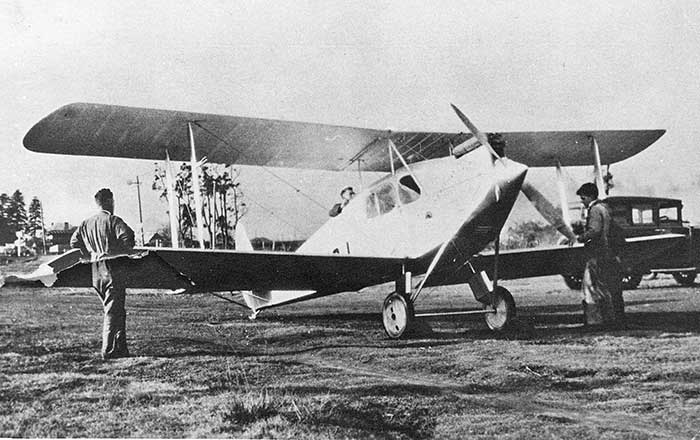
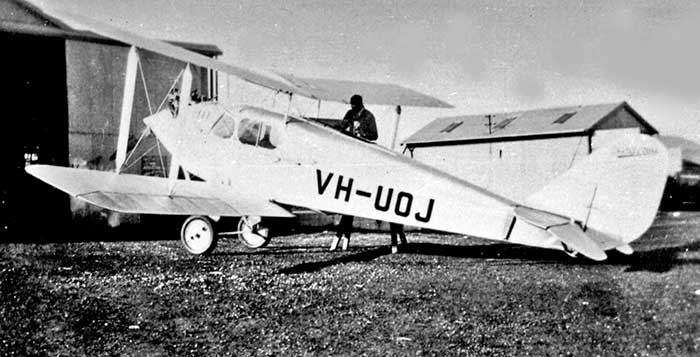
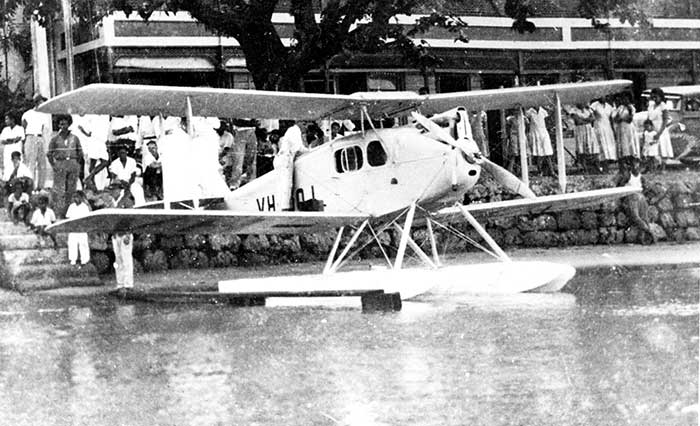
Photo: Alan Bovelt collection
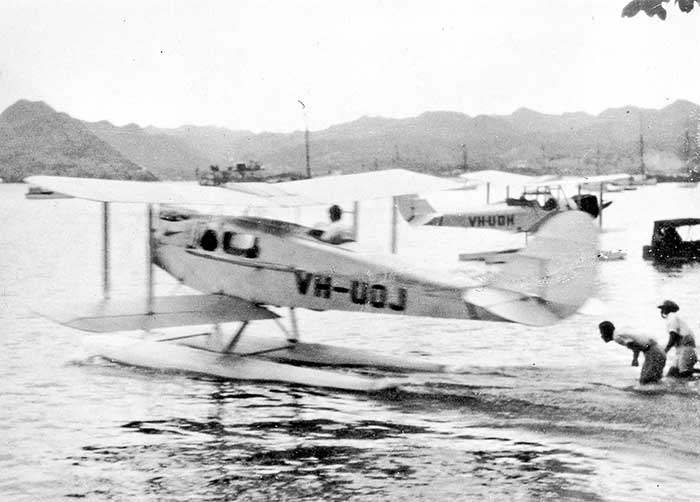
Photo: George Beohm via Frank Walters collection
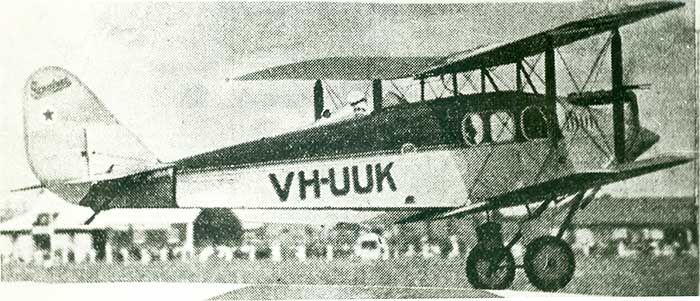
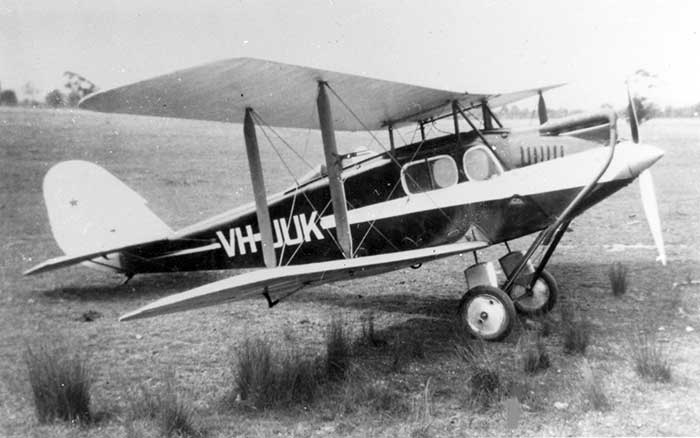
Genairco c/n 19
La Roussette
VH-UOS, New Caledonia
| 13.8.30 | Completed by General Aircraft Co Ltd in their hangar at Mascot Aerodrome, Sydney NSW Fitted with a German-built 120hp Siemens-Halske SH12 radial engine |
|
Difficulty in obtaining the required CAB certification data delayed the first flight | |
| 10.11.30 | Added to Civil Register VH-UOS: General Aircraft Co Ltd, Cook Street, Mascot Aerodrome |
| 29.1.31 | First flight Mascot |
| 28.2.31 | Inspection report by CAB Inspector: first class workmanship, very good finish. Cockatoo Dockyard aeronautical section (L.J.Wackett) had designed and built the engine mount for the radial engine, as well as designing the new 6 feet diameter wooden propeller which was built by General Aircraft Co. |
| 9.5.31 | Change of ownership: N. Stirling, Brisbane Qld |
| 20.5.31 | CofA issued. Delayed due CAB concern over differences with the standard Genairco. |
| 7.6.31 | Inspection Report at Archerfield Qld: Total airframe time: 30 hrs 15 mins |
| .31 | Ordered received by GAC
from Maurice Rolland and C.L. Brown, Nouma, New Caledonia. They planned
to commenced a floatplane service between islands in New Caledonia. |
| 7.31 | Repossessed by General Aircraft Co Ltd, Mascot Aerodrome |
| 7.31 | Sold by GAC to Maurice Rollands, Noumea, New Caledonia |
| 21.8.31 | George Beohm of GAC wrote to CAB advising that VH-UOS had been shipped to Noumea |
| 15.9.31 | Shipped to Noumea as cargo on board SS La Perouse |
| 16.9.31 | Struck-off Australian Register as sold to New Caledonia |
| Flown in New Caledonia as landplane VH-UOS, named La Roussette Painted with military style roundels and fin flash | |
| 14.1.32 | Badly damaged at Koumac, New Caledonia. Reportedly crashed into a fence and fuselage broke its back |
| No indication that floats were fitted in New Caledonia prior to the crash | |
| - | Shipped back to Sydney for rebuild by General Aircraft Co. |
| Rebuild not commenced prior to the company ceasing operations in April 1934 | |
| Damaged aircraft stored in Sydney | |
| 4.5.38 | Wally Kuhl of WHK Engineering and Airflite Pty Ltd at
Mascot wrote to DCA advising that he had was considering rebuilding
VH-UOS with the original Siemens-Halske SH12 radial engine. Kuhl had repaired the engine mounting which had been damaged in the 1932 accident in New Caledonia |
| Siemens-Halske engine and engine mount sold by Kuhl to Edward Macarthur-Onslow c/- Macquarie Grove Flying and Glider School Pty Ltd, Camden NSW | |
| 11.3.40 | Macquarie Grove Flying and Glider School Pty Ltd requested DCA approval to install the Siemens-Halske SH12 radial from VH-UOS in their Genairco VH-UOF. Approved by DCA |
| Apparently no action taken due to the war situation | |
| 18.9.45 | DCA memo: Lt Col Edward Macarthur-Onslow has just returned from overseas wartime service. He will soon advise on his plans for the Macquarie Grove Flying School which ceased operations in 1940 when RAAF requisitioned their airfield and facilities. |
| 9.45 | Change of owner's name: Edward Macarthur-Onslow, Camden NSW |
| 2.4.47 | Macquarie Grove Flying School, Camden wrote to DCA in response to a request for their plans for VH-UOS: advised that the aircraft had been destroyed, but gave no details |
| Unconfirmed report that the stored airframe was in poor condition and was burnt, along with Genairco VH-UOF |
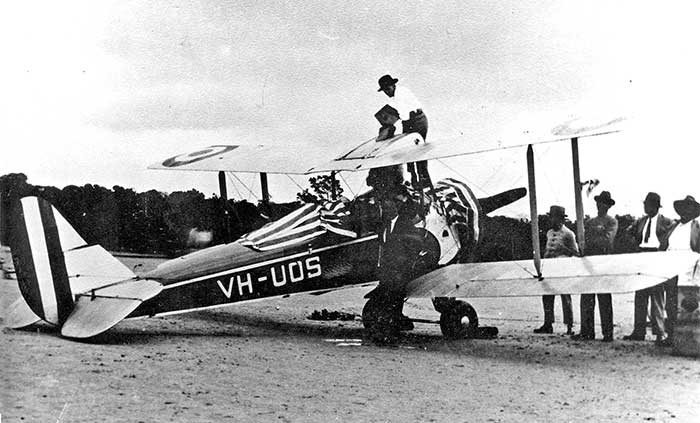
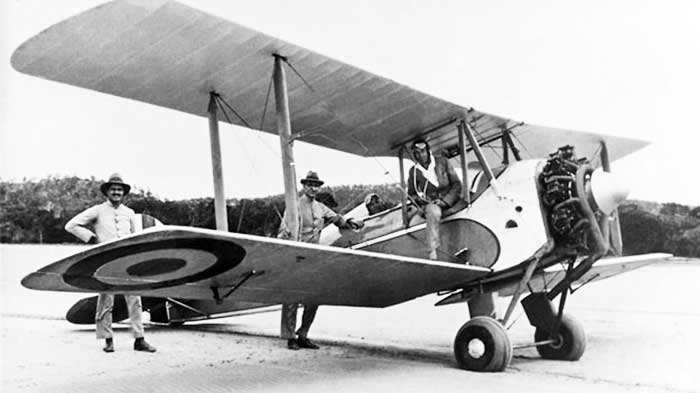
| 11.33 | Construction
began at Mascot Aerodrome on a Genairco two-cockpit floatplane by
Messrs Leo Turl and Frank Gannon. It was the first major job for new company Turl and Gannon, which leased the formner General Aircraft Co hangar. The business Turl and Gannon was soon re-financed under the new nme Tugan Aircraft Company Ltd. |
| Built to the order of Rabaul Airways, Rabaul, New Britain, as a replacement for their Genairco floatplane VH-UNY which crashed near Rabaul on 15 October 1933. The wreck of VH-UNY was shipped to Sydney to provide parts for this new aircraft | |
| 22.12.33 | CAB
memo: the Genairco floatplane under construction will be fitted with a
coupe top designed to enclose both cockpits. Engine is an inverted 120hp DH Gipsy III with new cowling design |
| 1.34 | CAB
memo: construction progressing, due to fly in March 1934. Stress analysis and drawings being supplied by aeronautical
engineer L.J. Wackett who is employed by Tugan Aircraft Ltd. He has
designed the floats and superstructure for this aircraft |
| Wooden floats with water rudders built at Cockatoo Dockyard Aircraft Division | |
| Rabaul Airways' pilot/mechanic Charles Gatenby sailed to Sydney to arrange the despatch of the new aircraft by ship to Rabaul | |
| 3.34 | First test flight |
| 12.3.34 | Weighed at the Cocktoo Dockyard Aircraft Division in Sydney Harbour.Aircraft painted all white. |
| 14.3.34 | First
flight at Iron Cove, Sydney Harbour, pilot George Littlejohn. Further flights by CAB inspector Dave Ross, to compile performance figures with floats. Ross reported that takeoff, climb and handling performance were all satisfactory |
| 4.4.34 | CofA issued |
| 4.4.34 | Added to Register VH-URH: Rabaul Airways, Rabaul, New Britain |
| 5.4.34 | Loaded on board the coastal steamer SS Macdhui which left Sydney that day for New Guinea, accompanied by Gatenby. |
| 15.4.34 | Arrived at Rabaul by ship |
| Assembled at Rabaul by Gatenby as a floatplane. Flown by Rabaul Airways chief pilot Charles Gatenby | |
| 20.4.34 | Gatenby
flew from Rabaul to Madang and the Sepik River to investigate a
floatplane service to supply gold miners but they found that the
popular Ray Parer had beaten them |
| 5.34 | Gatenby left Rabaul on a
charter to collect a passenger at Kabakaui and fly him to Marau
Plantation and back to Kabakaui same day. He was unable to get airborne at Kabakaui and found that one float had a leak and was filling with water. After hastily beaching the aircraft, Gatenby made rough repairs to the float, then flew to Marau. On departure Marau later the same day, the float hit a breaker wave over a reef, damaging the float strut. Gatenby and his passenger clung to a wingtip to keep the aircraft level while they drifted back to the beach with the tide. Next day Gatenby repaired the bent strut but they did not have sufficient fuel. Unable to obtain any petrol locally, Gatenby saw an Administration schooner out to sea, so took off and chased it, circling the vessel signalling the crew to divert to Marau anchorage. The vessel Captain gave Gatenby one 4 gallon drum of fuel. After stops at two other plantations seeking fuel, Gatenby finally delivered his hapless passenger back to Kabakaui four days late. |
| 5.34 | Reportedly did not fly again |
| 6.34 | Rabaul Airways ceased to exist. Gatenby left Rabaul to fly charter at Salamaua |
| Rabaul Airways Syndicate wound up. The Genaircoi floatplane was parked in its covered shed on Rabaul harbour | |
| VH-URH abandoned at Rabaul | |
| 3.4.35 | CofA expired. No reply to letters from CAB to Rabaul Airways |
| 3.4.35 | Struck-off Civil Register |
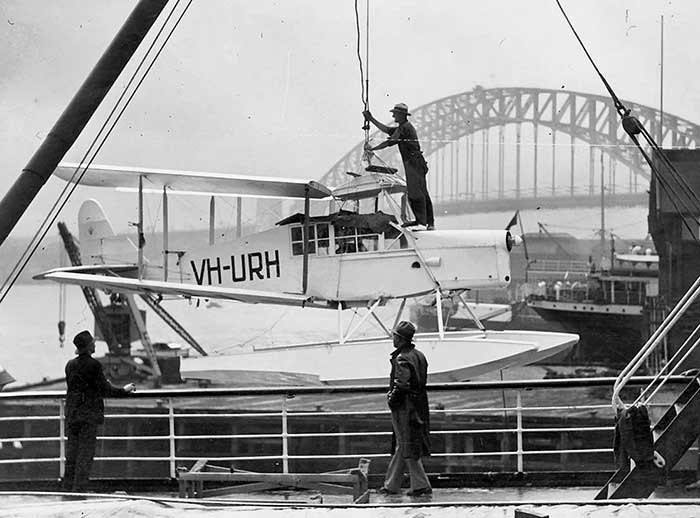
In the background is the newly completed Sydney Harbour Bridge. Hood collection, State Library of NSW
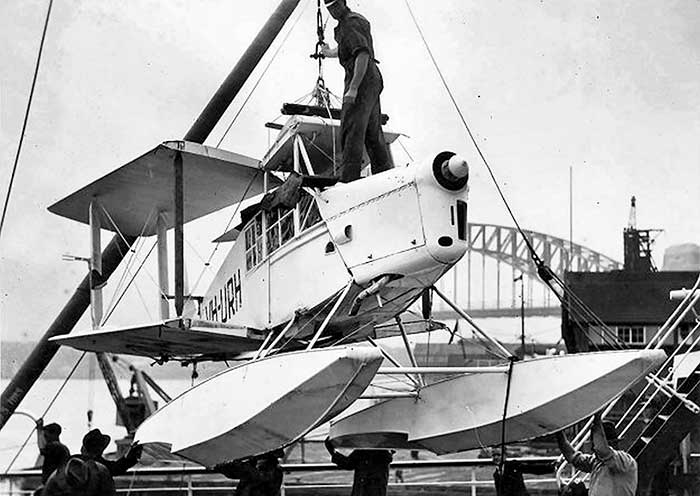
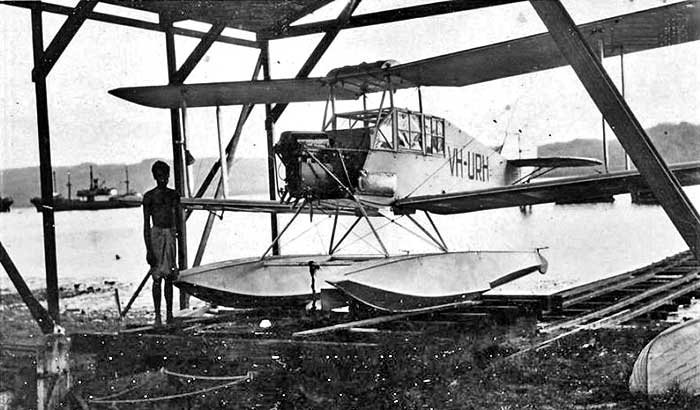
Photo: Walter Civitico collection
- CAB Civil Aviation Branch, Melbourne (1921-1936)
- CAB Civil Aviation Board, Melbourne (1936-1937)
- DCA Department of Civil Aviation, Melbourne (1937-1973)
- DOTA Department of Transport Air Transport Group, Canberra (1973-1982)
- DOA Department of Aviation, Canberra (1982-1987)
- DOTC Department of Transport and Communications, Canberra (1987-1988)
- CAA Civil Aviation Authority, Canberra (1988-1995)
- CASA Civil Aviation Safety Authority, Canberra (from 1995) + Airservices Australia handling airspace, ATC, airports, airport fire services
Priinciple source for this listing is the book Australian-built Aircraft and the Industry by Keith R.Meggs: Book One, 2009
- Additional detailed notes from Dave Prossor and Neil Follett
- Australian Civil Aircraft Register, Civil Aviation Branch (until 1936) and its successors
- CAB/DCA Aircraft files, National Archives of Australia, Melbourne
- DCA Annual Survey of Aircraft Accidents 1956-1968
- National Library of Australia - Trove newspaper archive website
- Aviation Historical Society of Australia Journal, numerous references 1960-1980
- Australian Air Log, monthly, numerous references 1965-1968
- British Civil Aircraft since 1919, A. J. Jackson, Volume 2, Putnam 1973
- Flypast A record of Aviation in Australia, Neville Parnell & Trevor Boughton, CAA 1988
- Complete Civil Register of Fiji, British Commonwealth Aviation News 1959, Air Britain
- Syd's Pirates, Charles E. Eather, Durnmount Sydney, 1983
- Virtue in Flying, Joan Priest, Angus & Robertson, Sydney 1975
- Wings of Gold - How the aeroplane developed New Guinea, James Sinclair, Pacific Publications,
Sydney 1978
- Airline, Ian Driscoll, Shortland Publications, Auckland: refs to Fiji Airways
- Airmen I Have Met, Derek Rolland, self-published 1999
- Classic Wings quarterly magazine, renamed Classic Wings: various references to Genairco
- Auction catalogue for Joe Terteling Collection sale at Boise Idaho 20.9.86
- British aviation magazines: 1986-1987 reports on the Terteling auction and sale results
- Fiji Register and operating companies, Pacific Islands Aviation Society 1968-1972, Alan Bovelt